Abstract
PURPOSE: First, to determine if thresholds exist for the development of amblyopia and subnormal binocularity with various types of anisometropia and to confirm or refute existing guidelines for its treatment or observation. Second, to delineate any association between the degree or type of anisometropia and the depth of amblyopia and severity of binocular sensory abnormalities. METHODS: Four hundred eleven (411) patients with various levels of anisometropia, no previous therapy, and no other ocular pathology were evaluated. The effect of anisometropia (both corrected and uncorrected) on monocular acuity and binocular function was examined. RESULTS: Spherical myopic anisometropia (SMA) of > 2 diopters (D) or spherical hypermetropic anisometropia (SHA) of > 1 D results in a statistically significant increase in the incidence of amblyopia and decrease in binocular function when compared to non anisometropic patients. Increasing levels of SMA and SHA beyond these thresholds were also associated with increasing depth (and in the case of SHA, incidence as well) of amblyopia. Cylindrical myopic anisometropia (CMA) or cylindrical hyperopic anisometropia (CHA) of > 1.5 D results in a statistically significant increase in amblyopia and decrease in binocular function. A clinically significant increase in amblyopia occurs with > 1 D of CMA or CHA. Increasing levels of CMA and CHA beyond > 1 D were also associated with an increased incidence (and in the case of SMA, depth as well) of amblyopia. CONCLUSIONS: This study provides guidelines for the treatment or observation of anisometropia and confirms and characterizes the association between the type and degree of anisometropia and the incidence and severity of amblyopia and subnormal binocularity.
Full text
PDF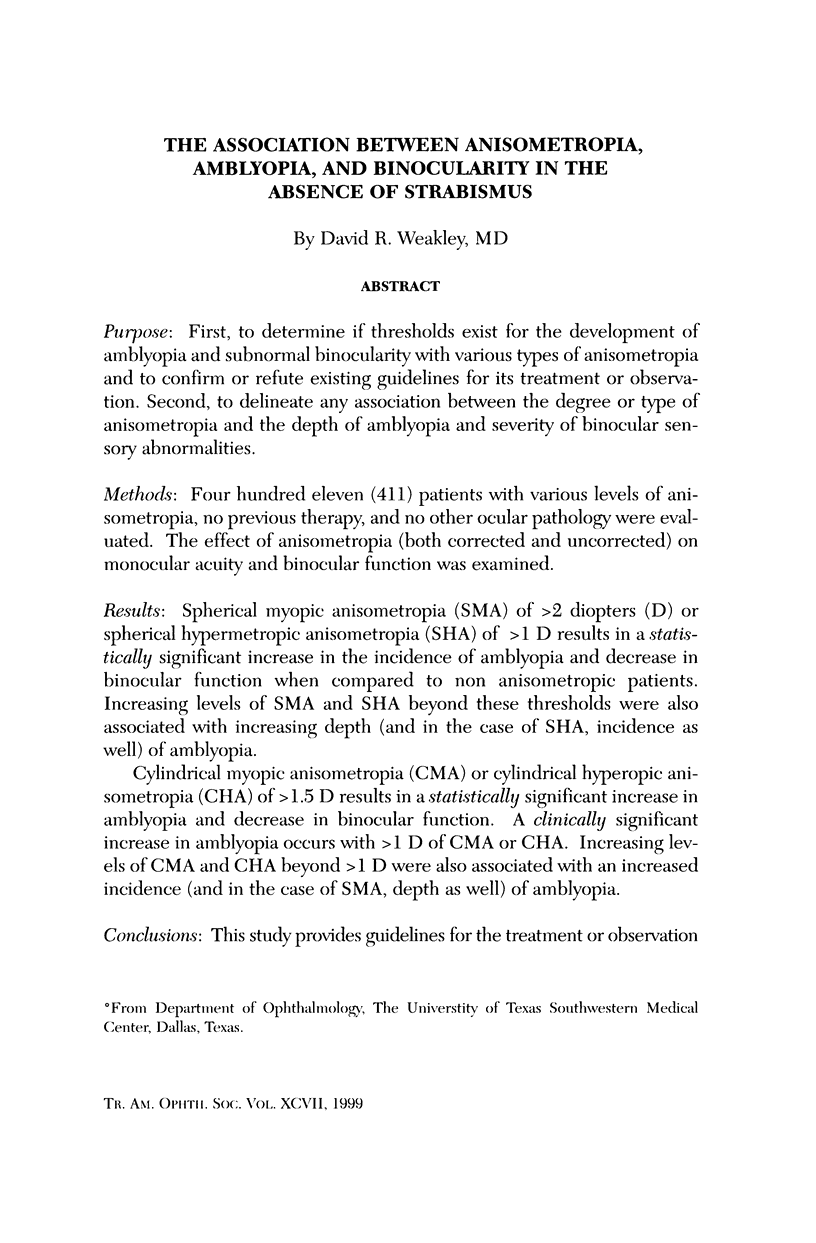
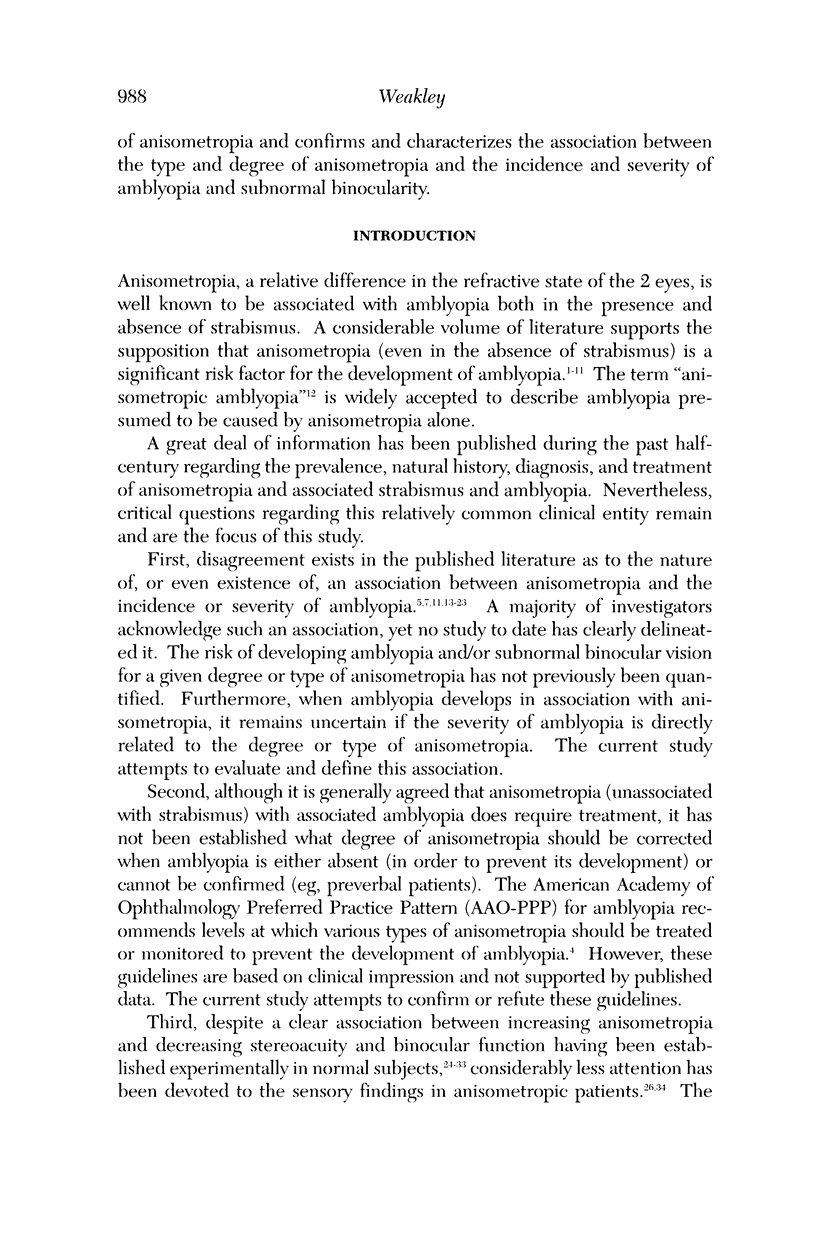
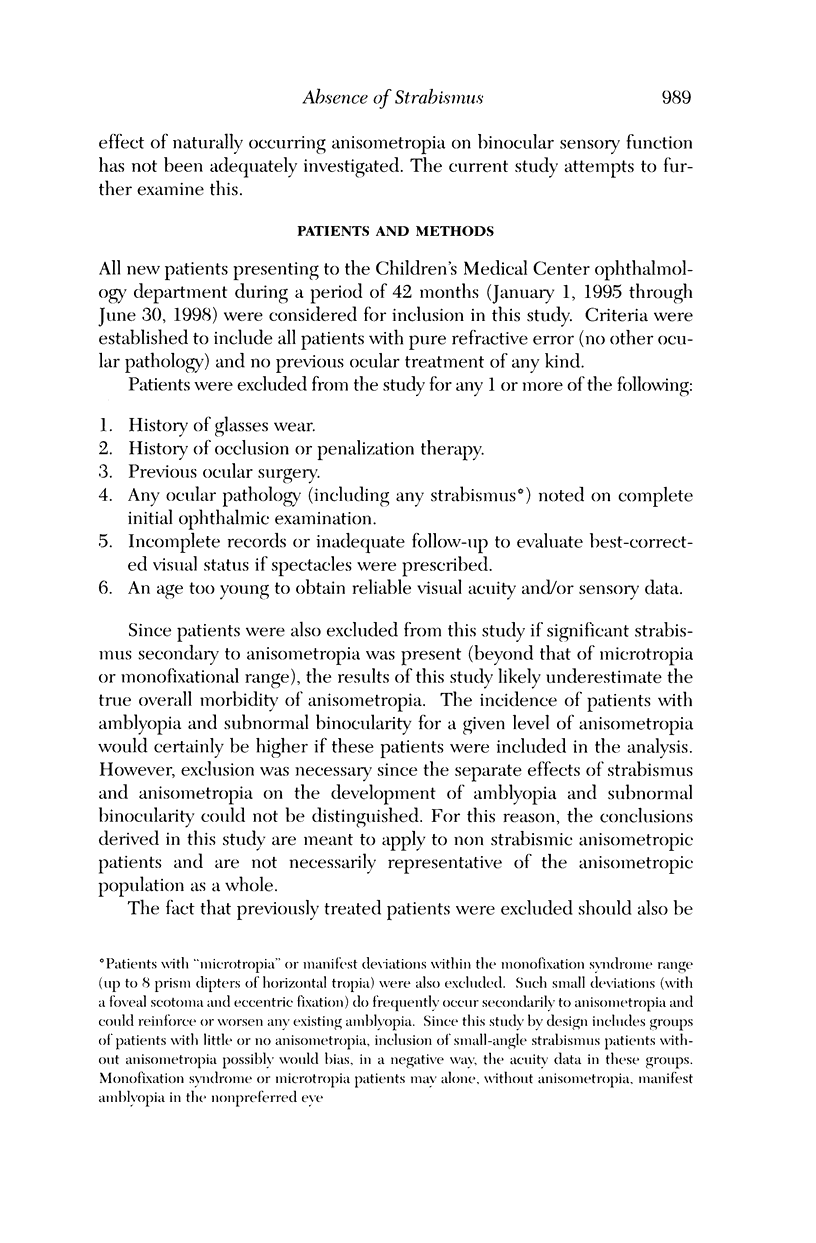
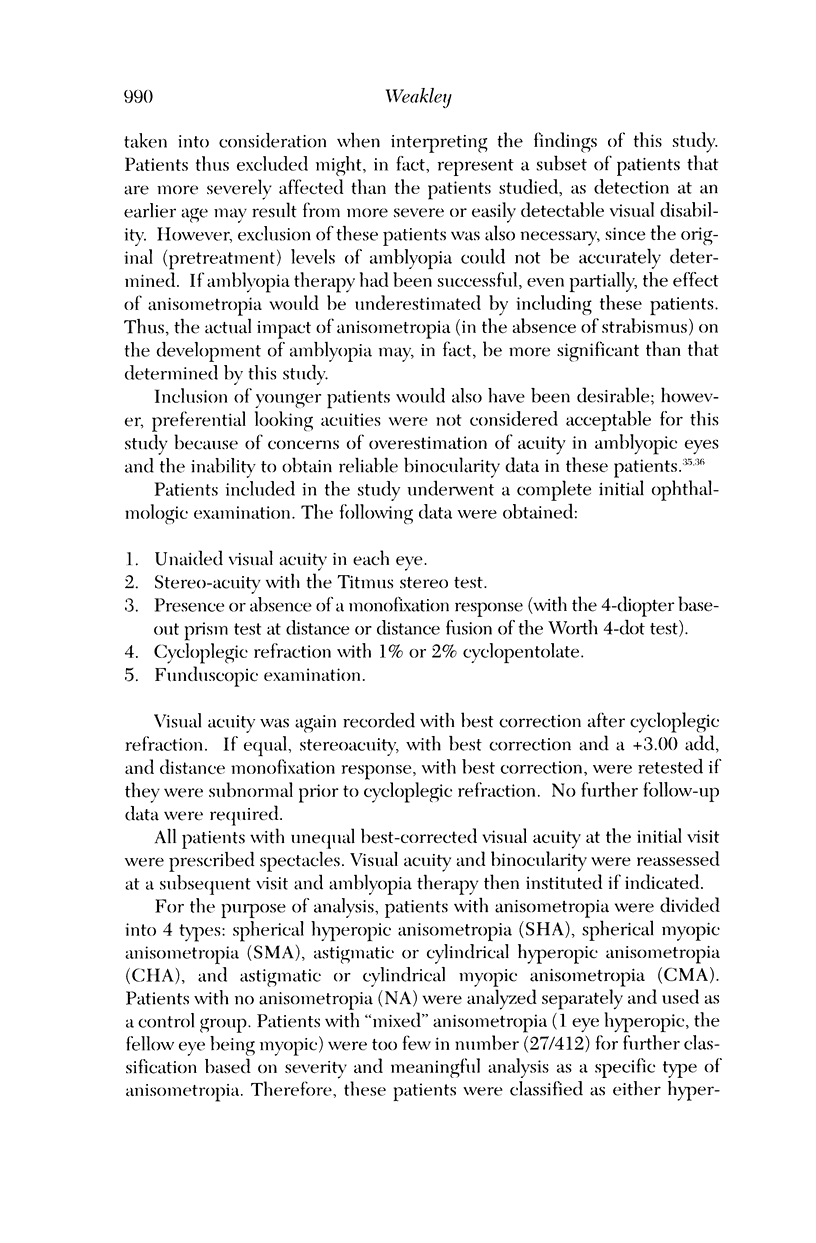
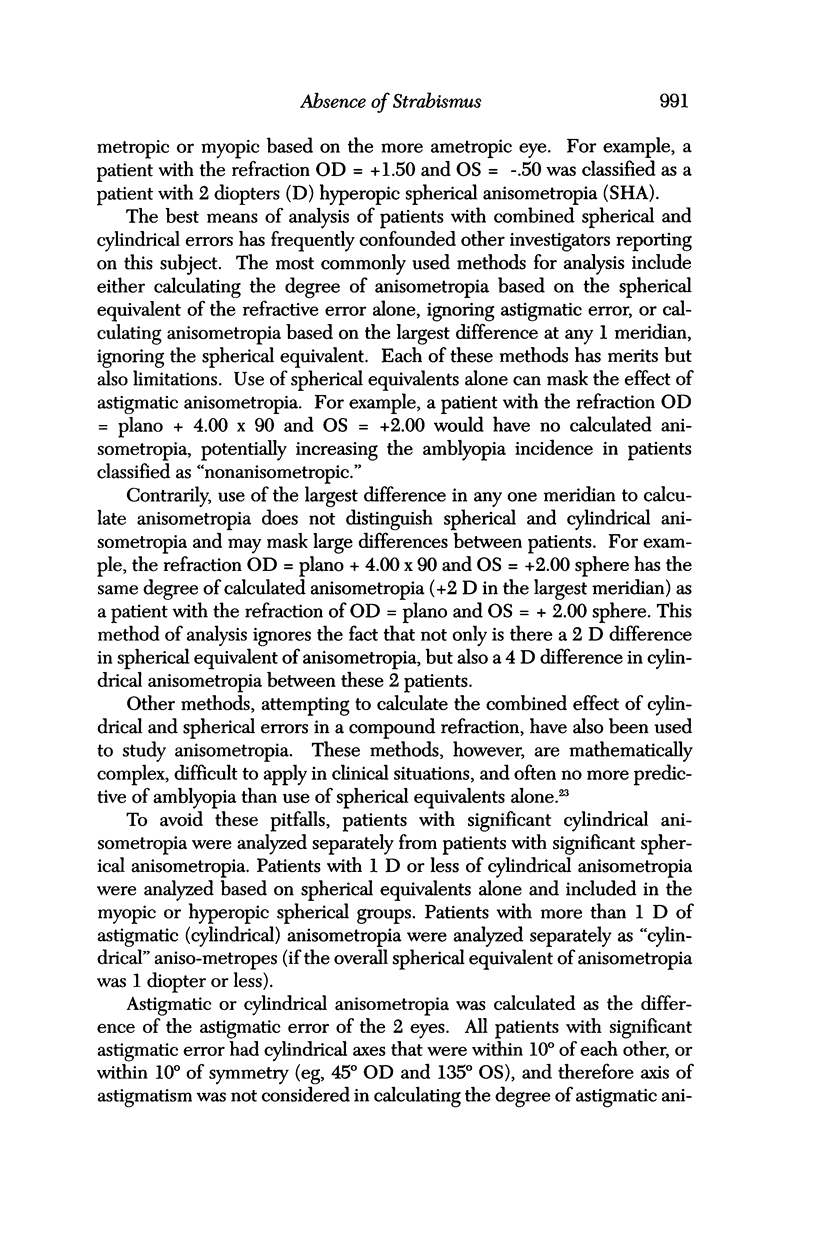
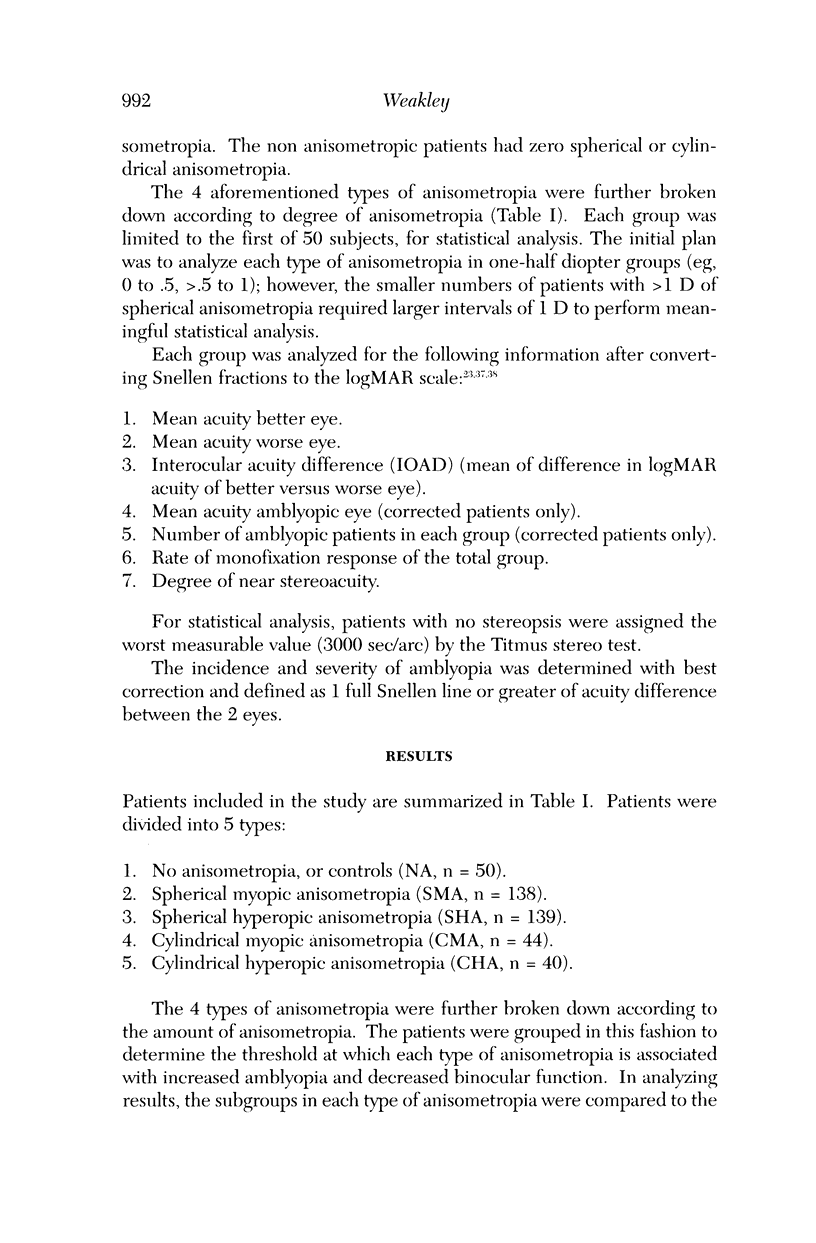
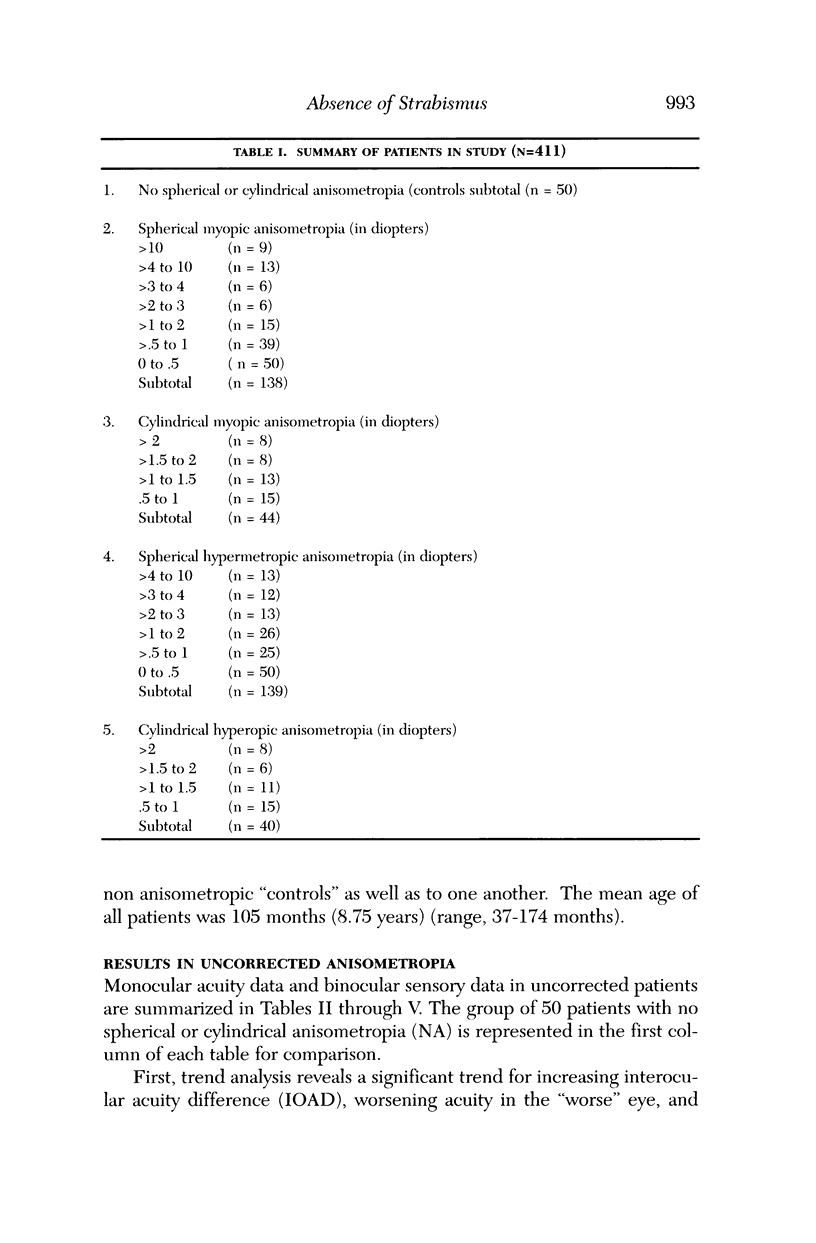
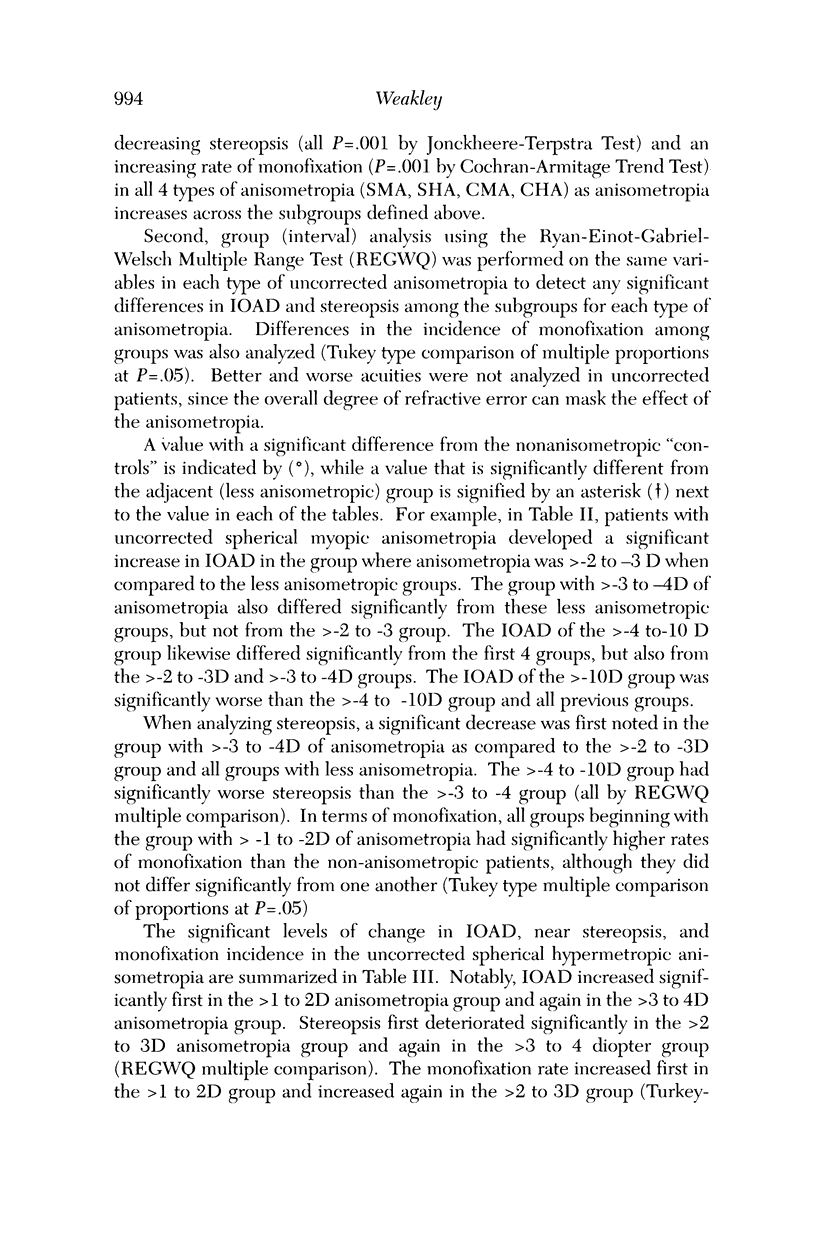
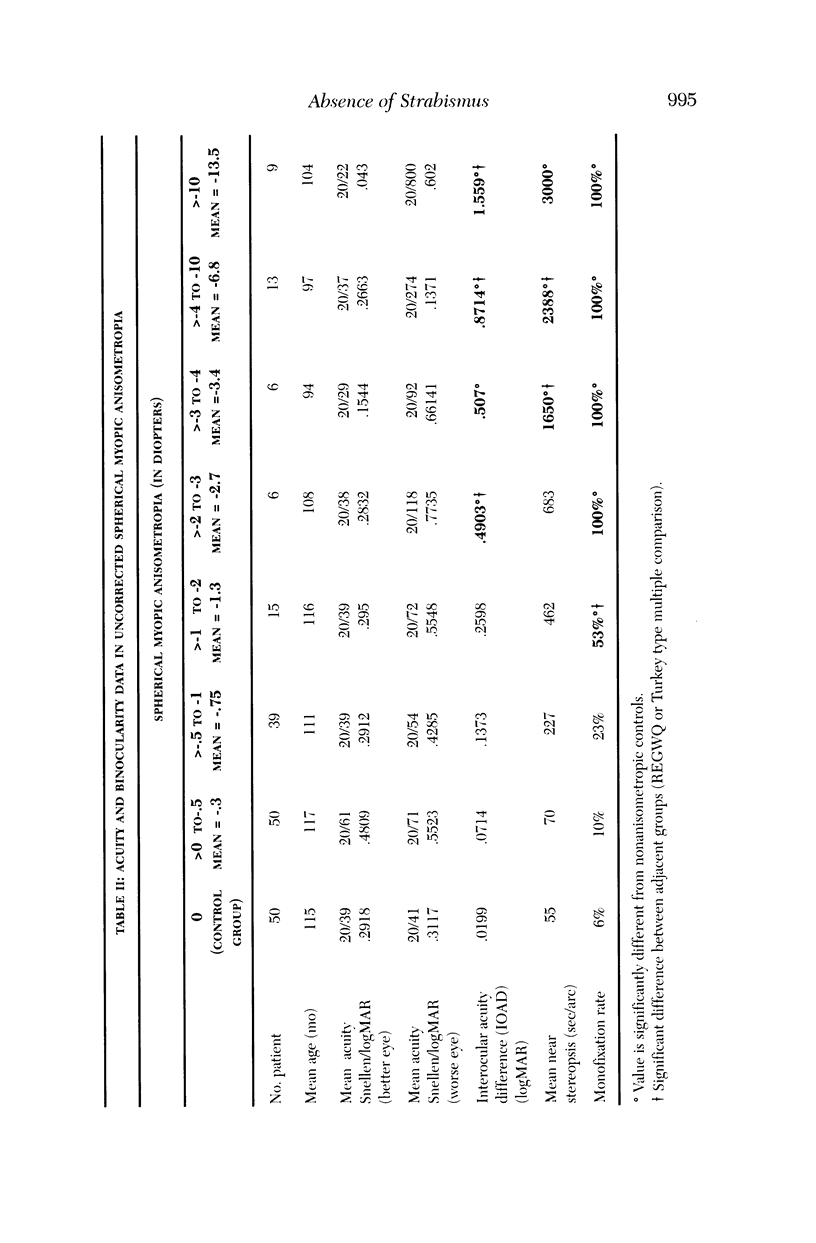
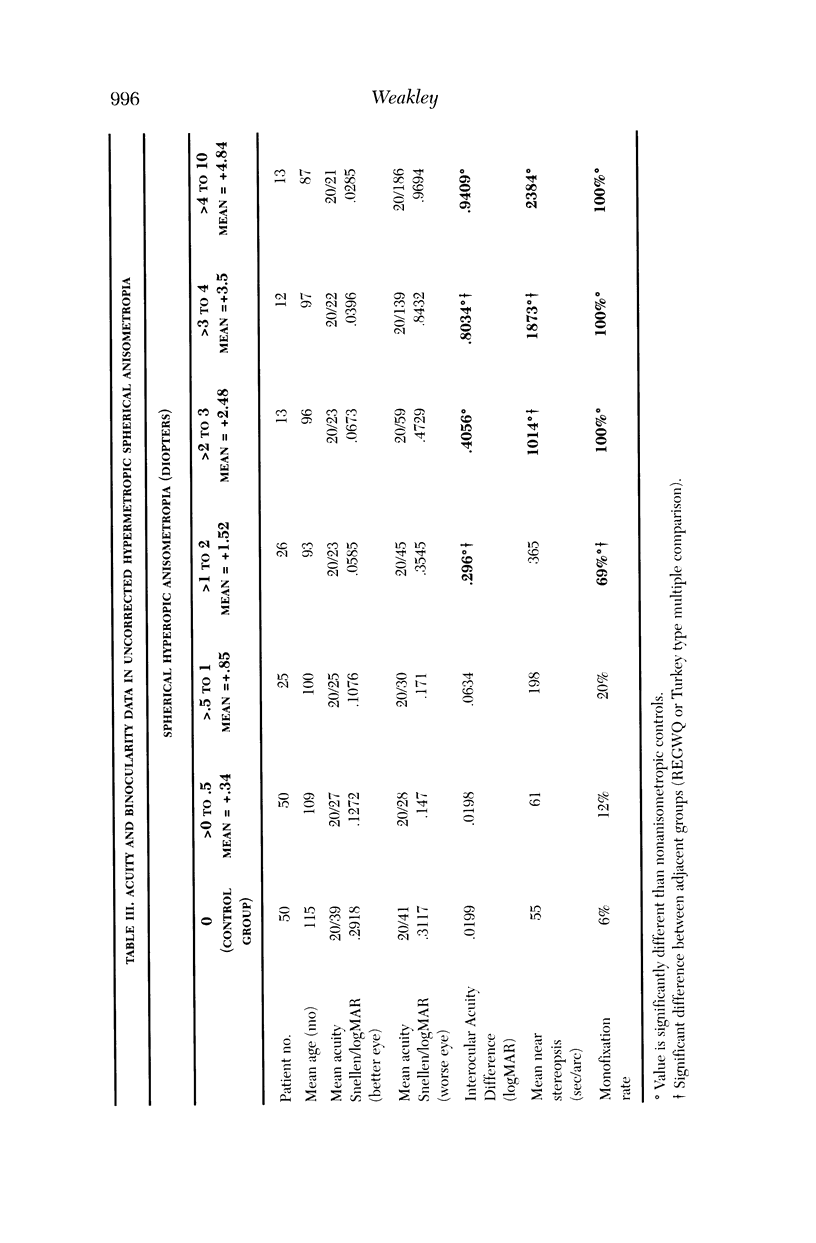
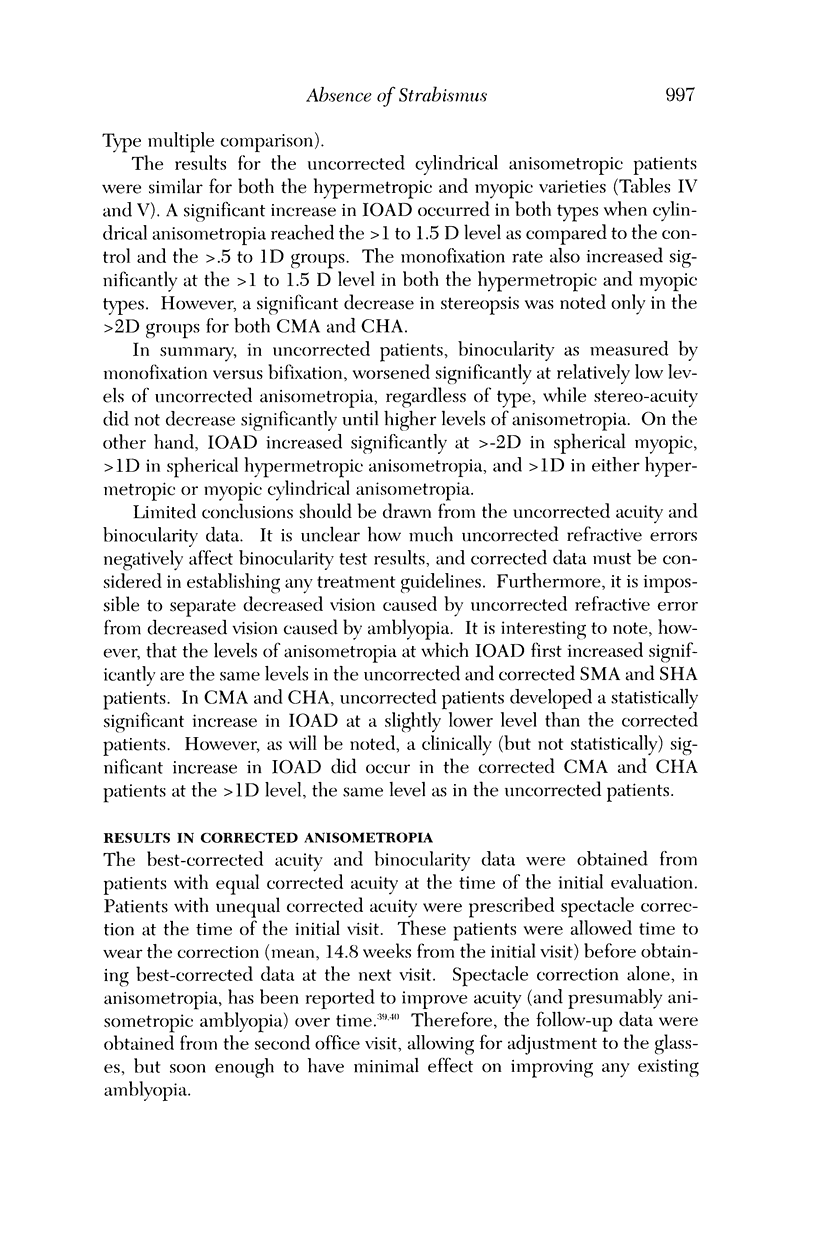
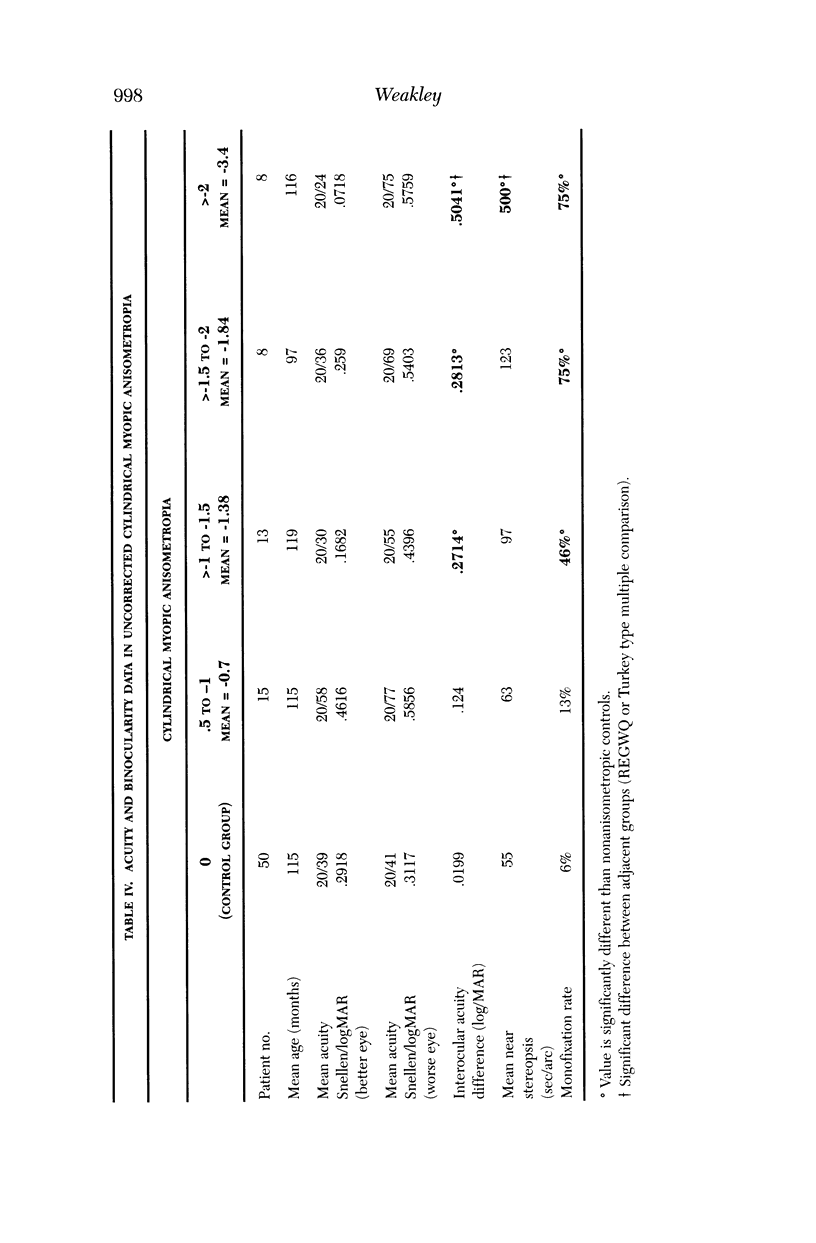
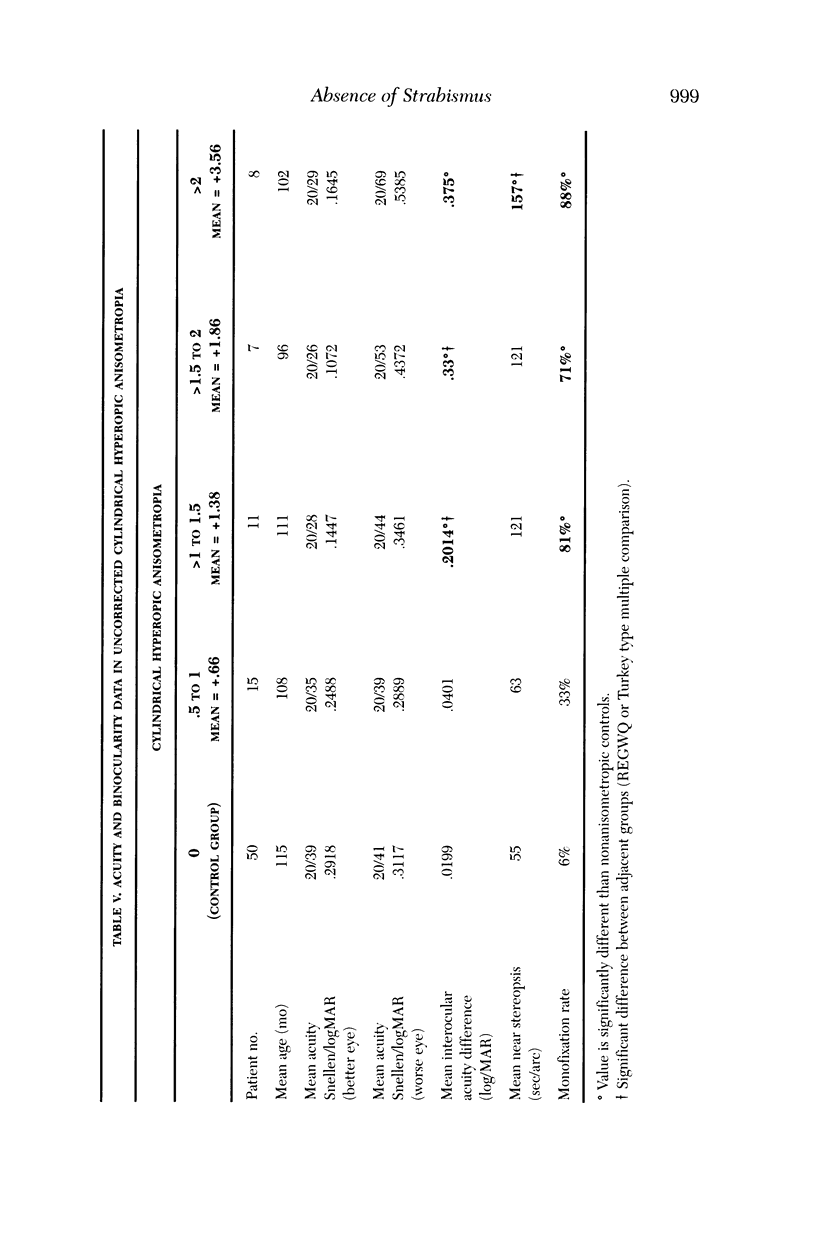
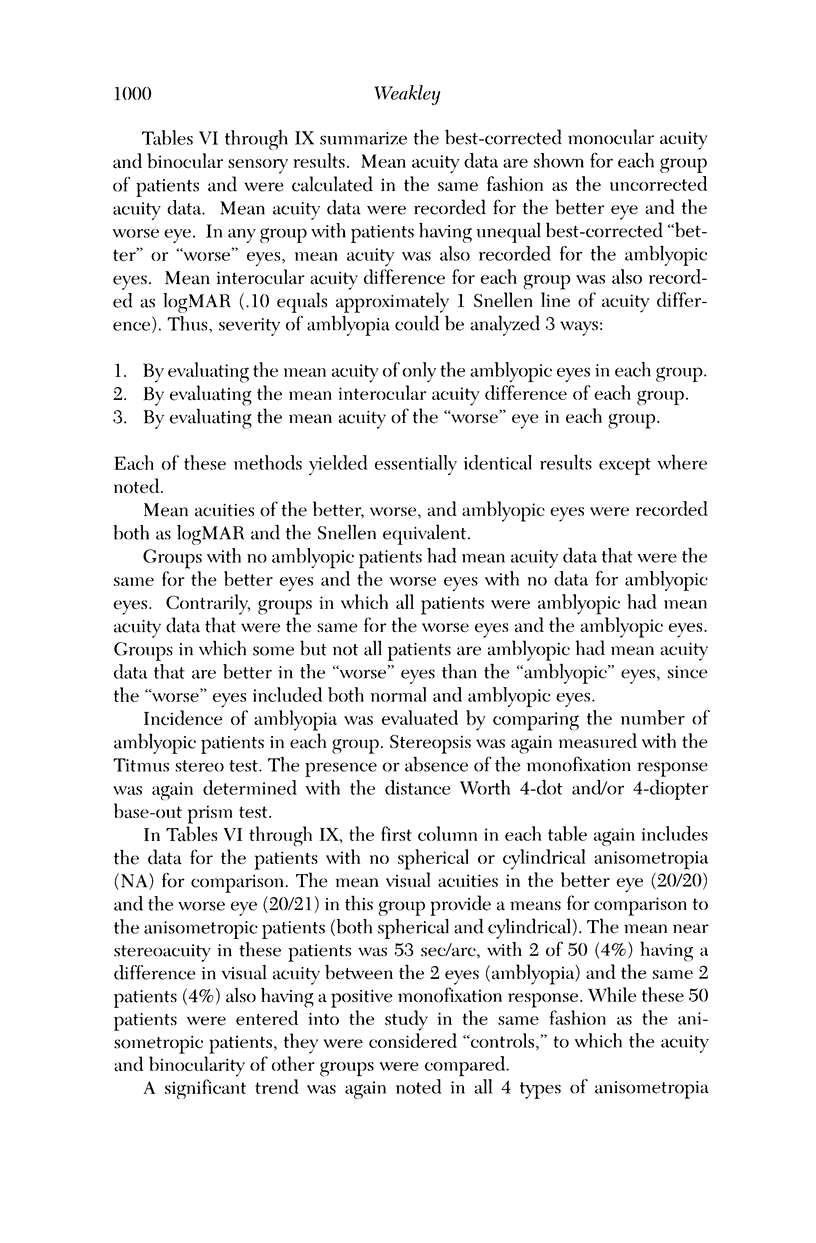
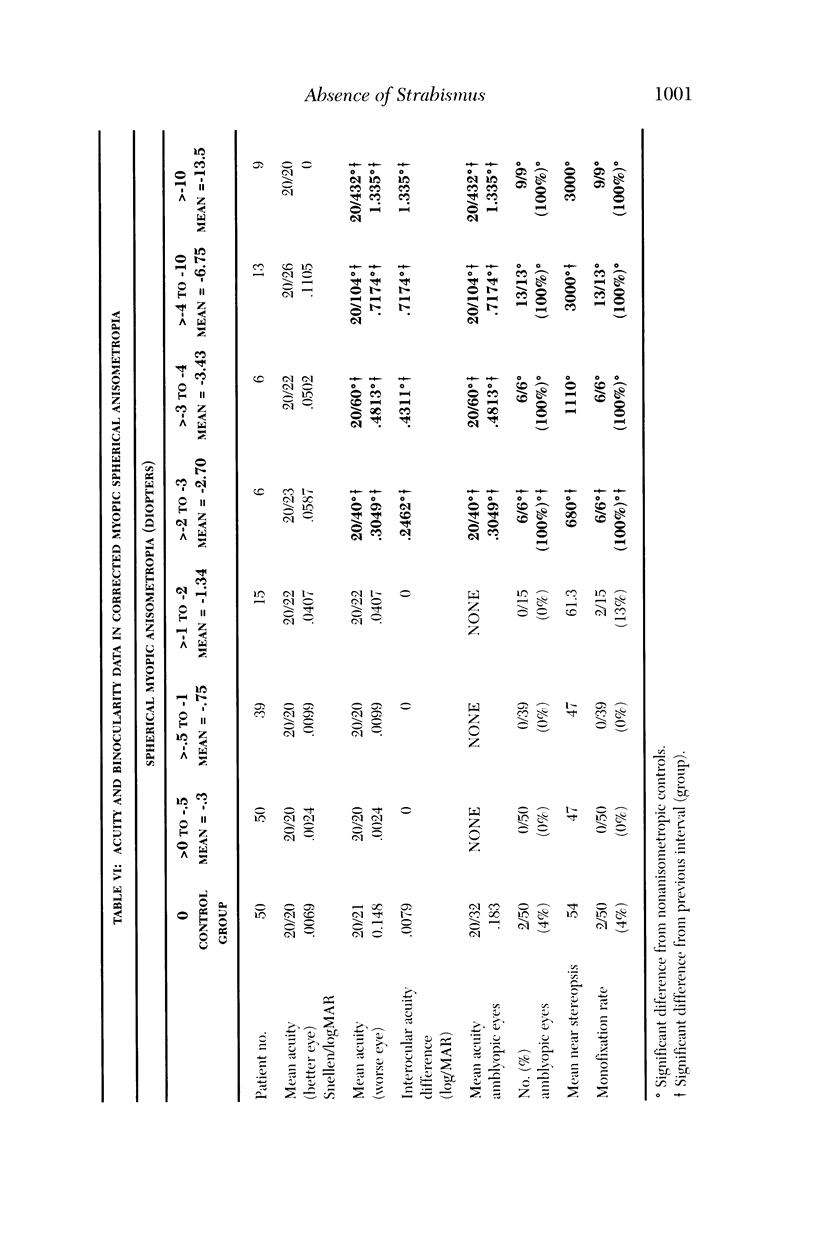
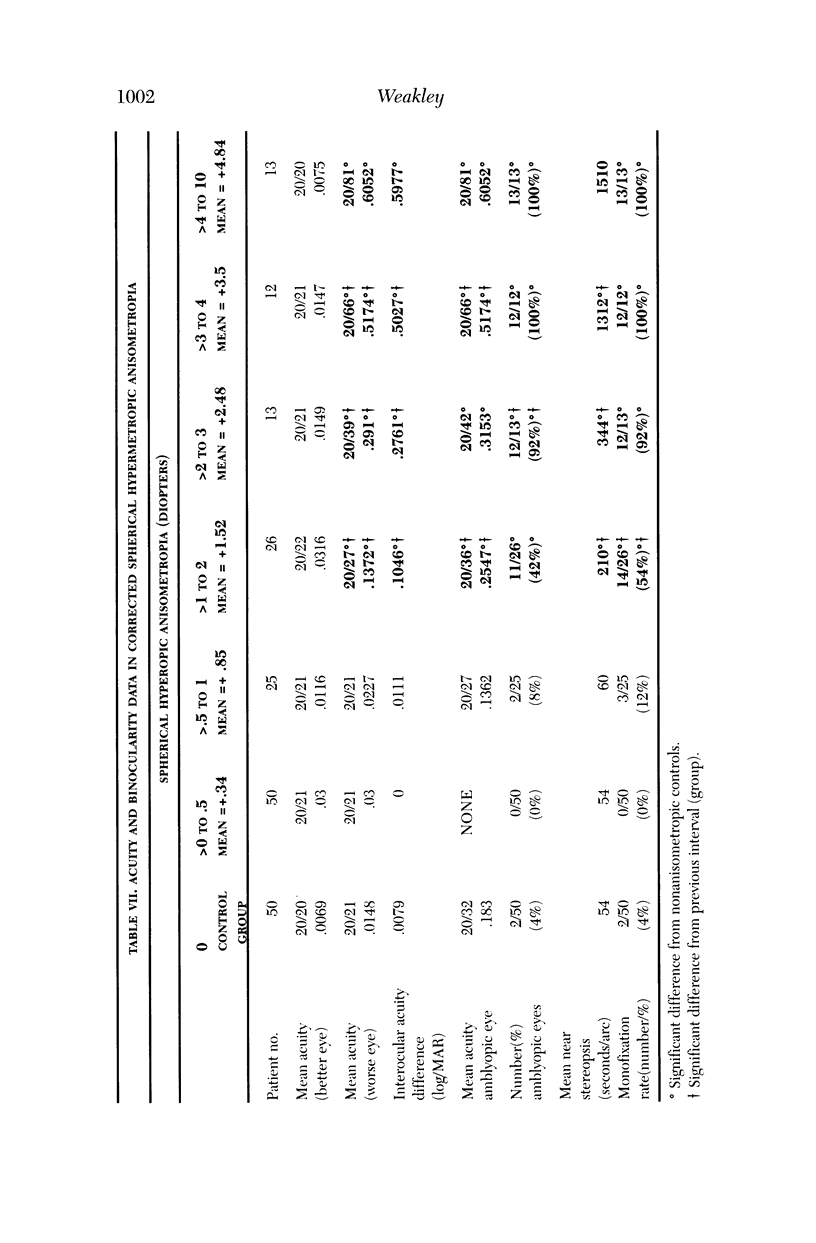
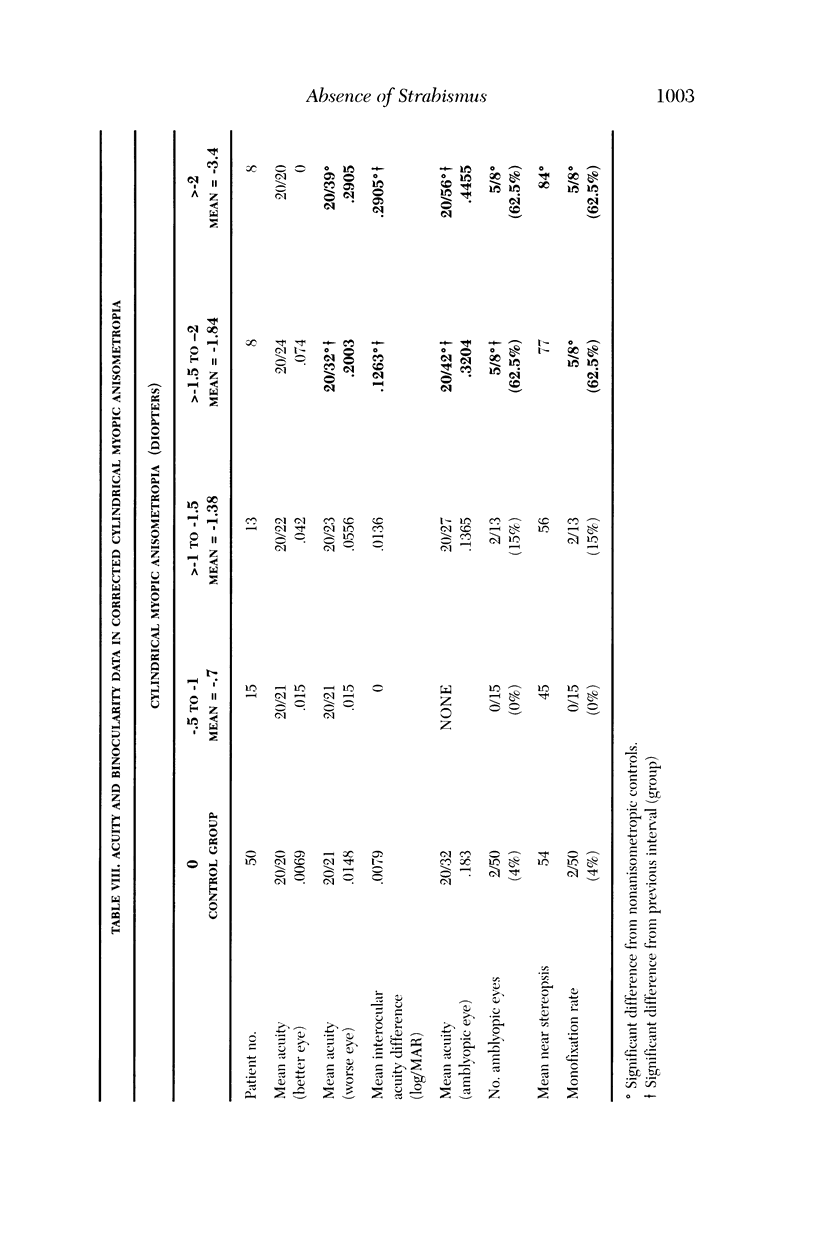
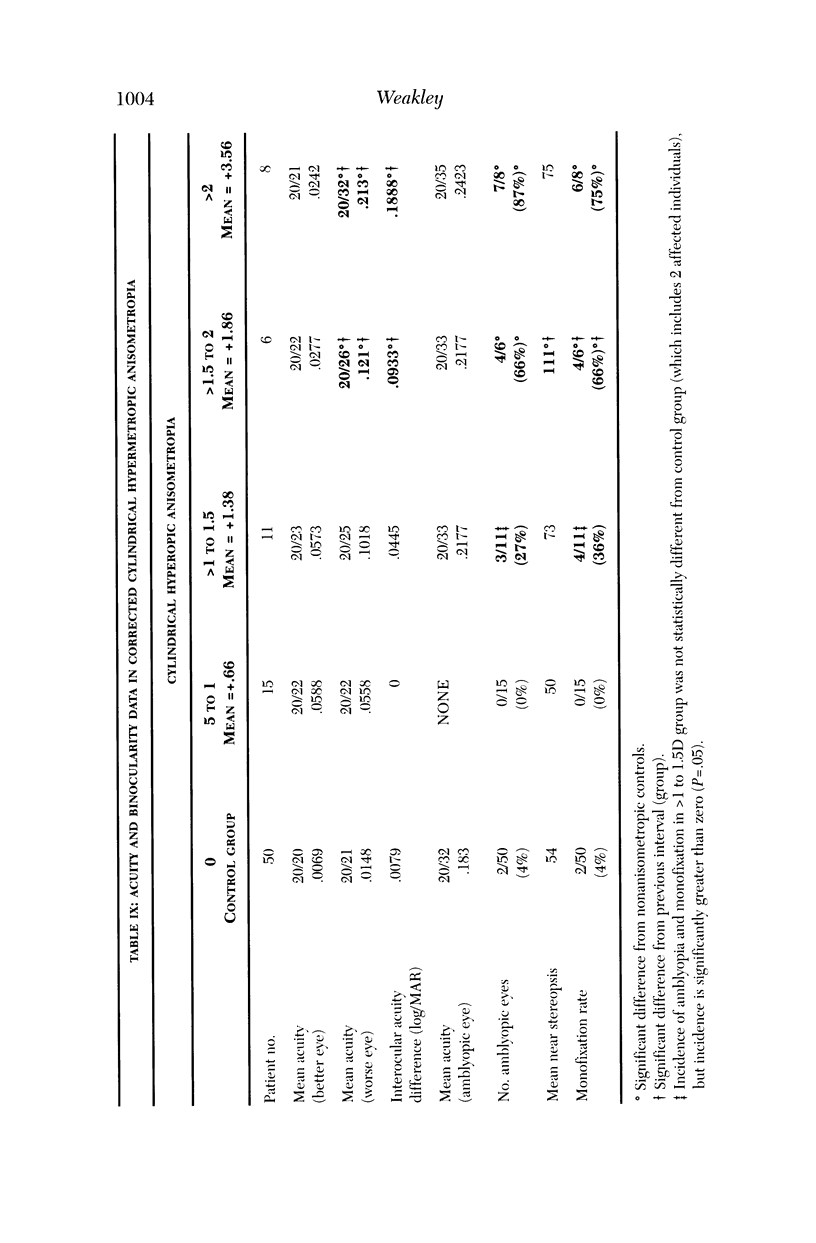
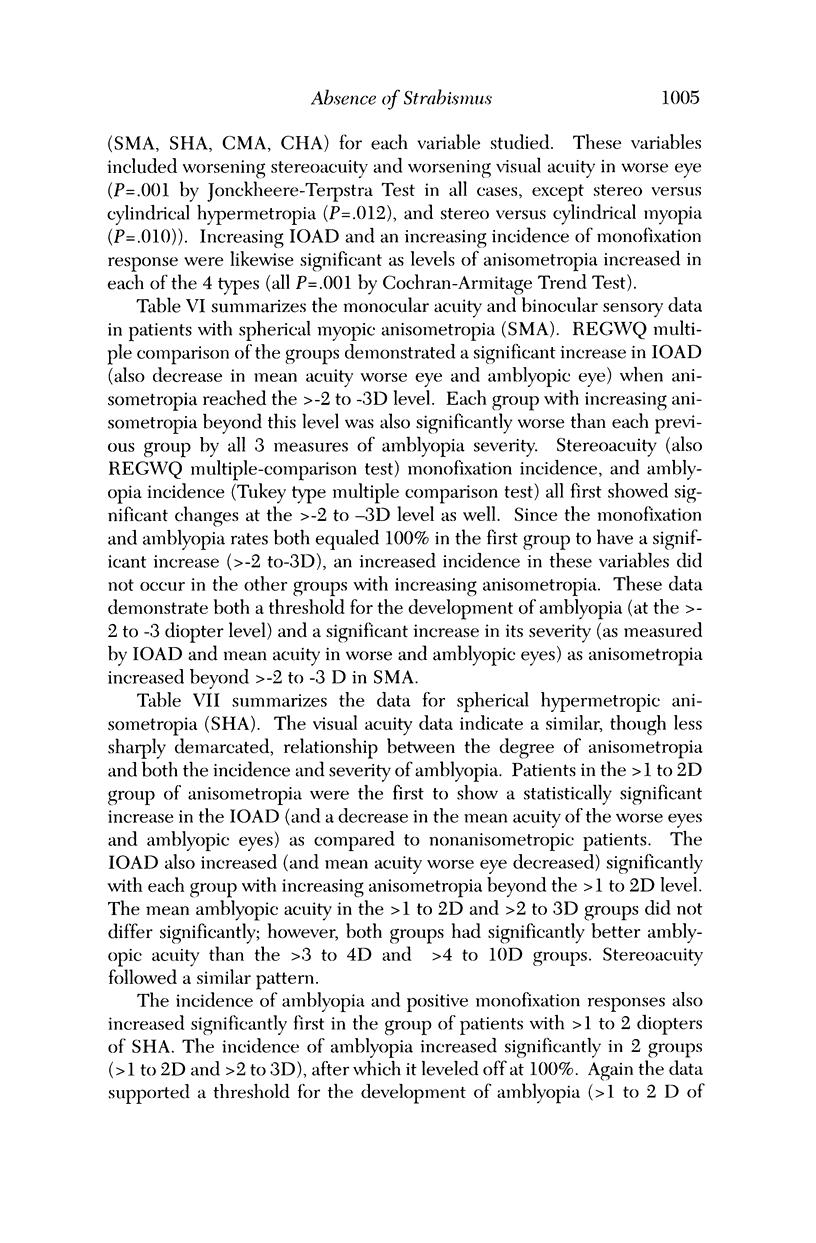
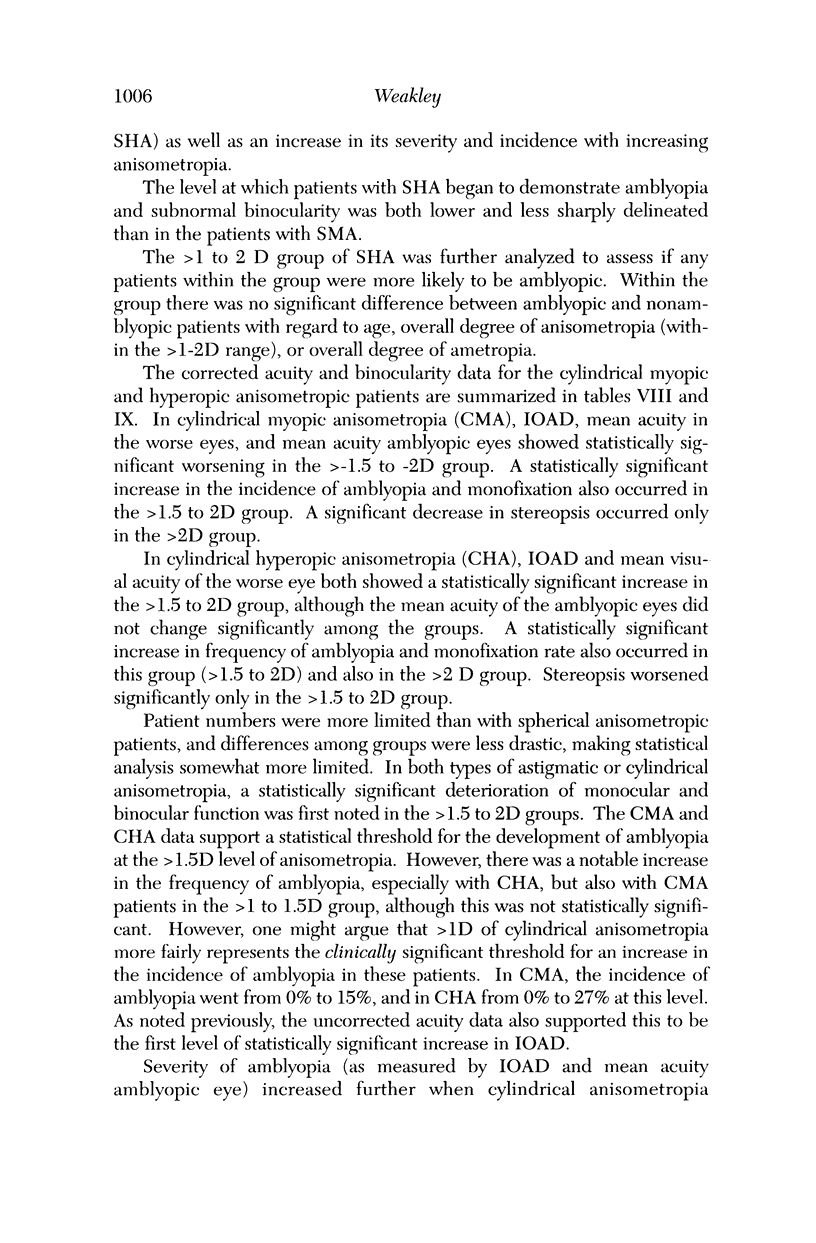
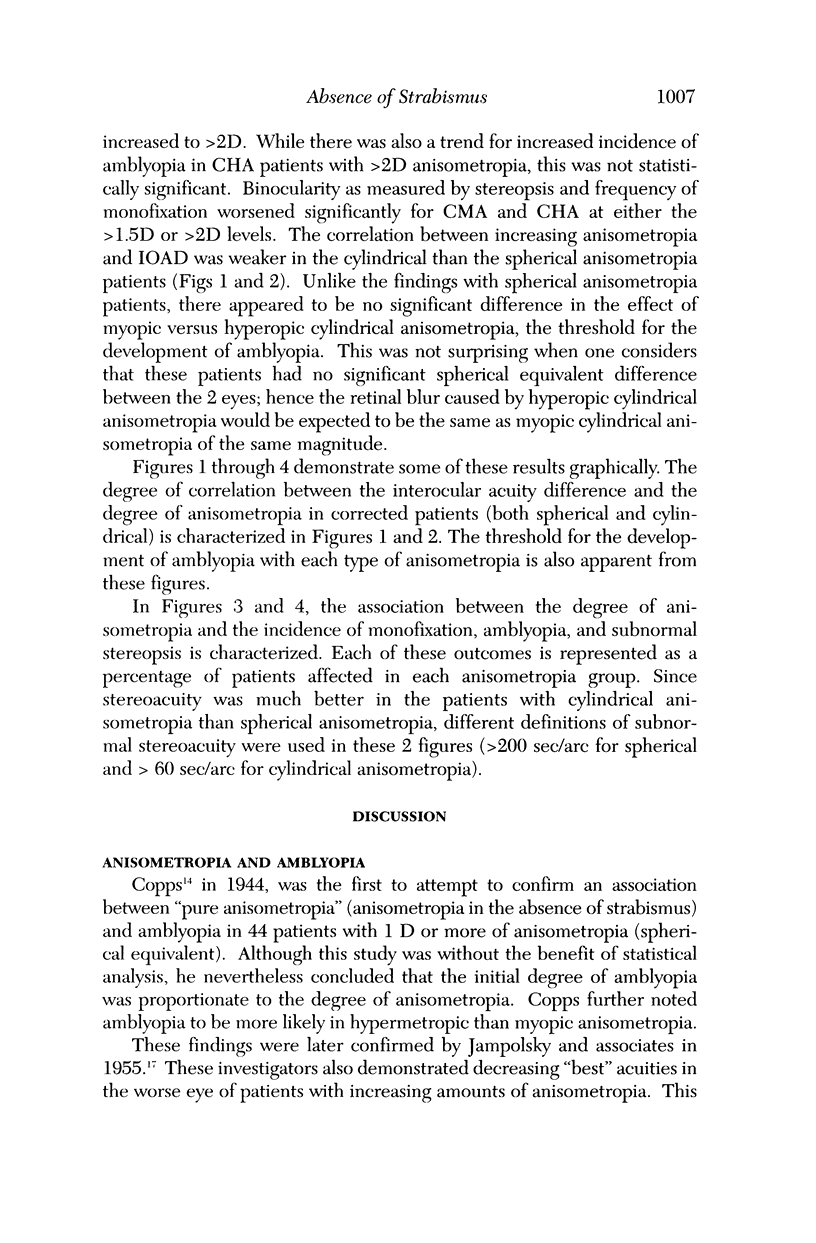
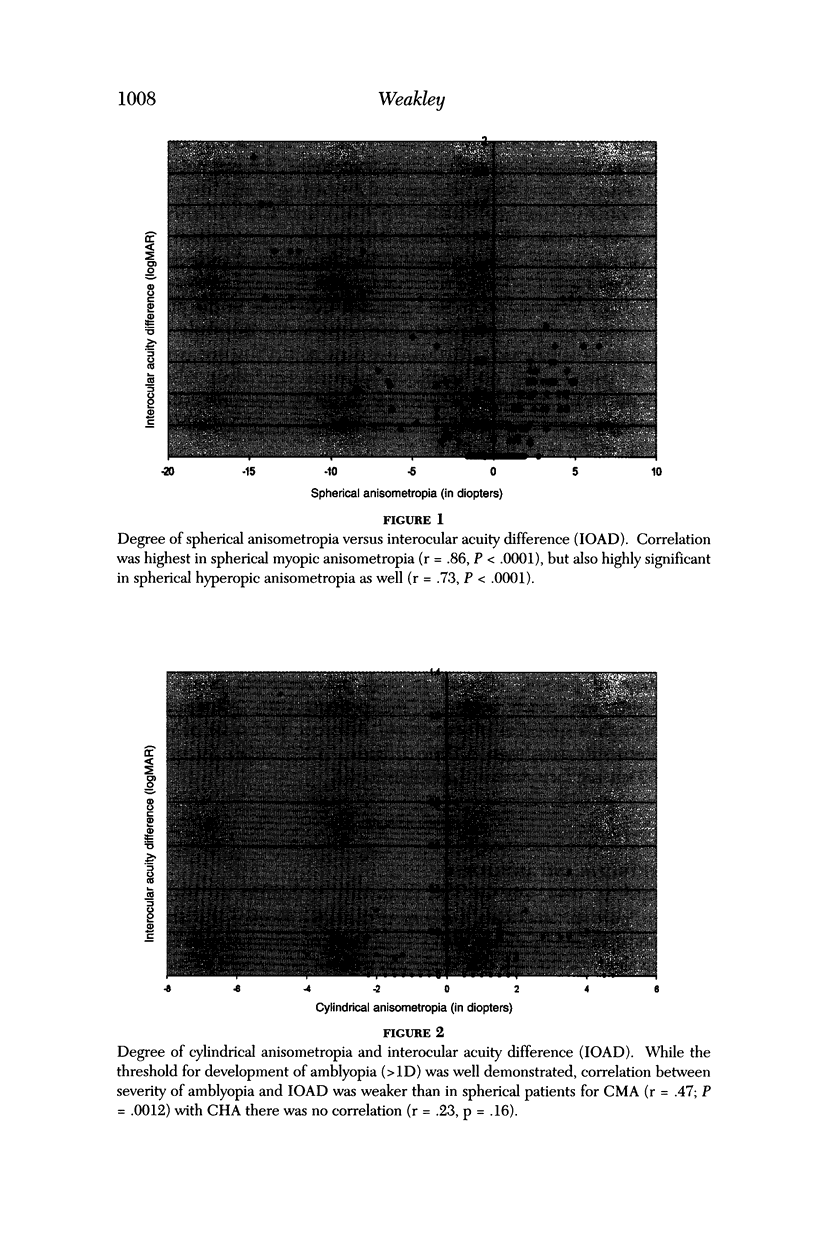
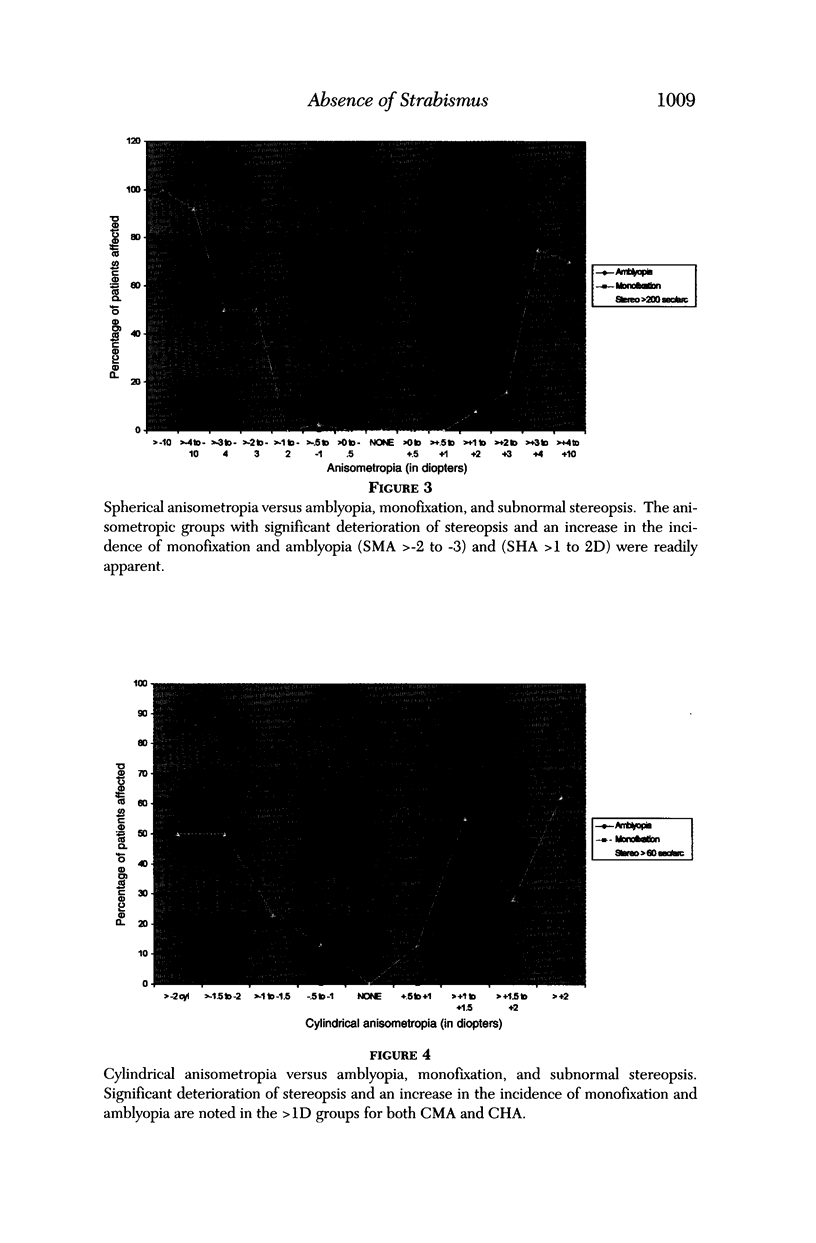
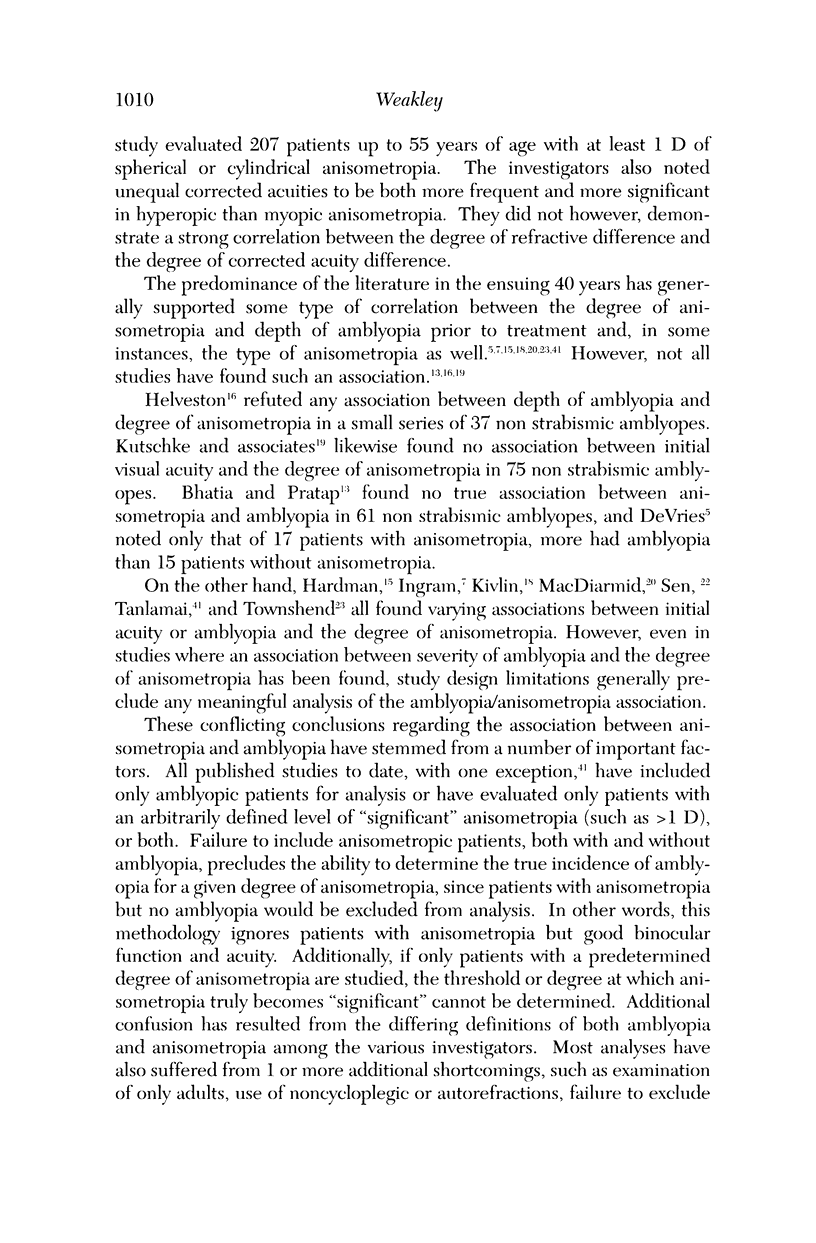
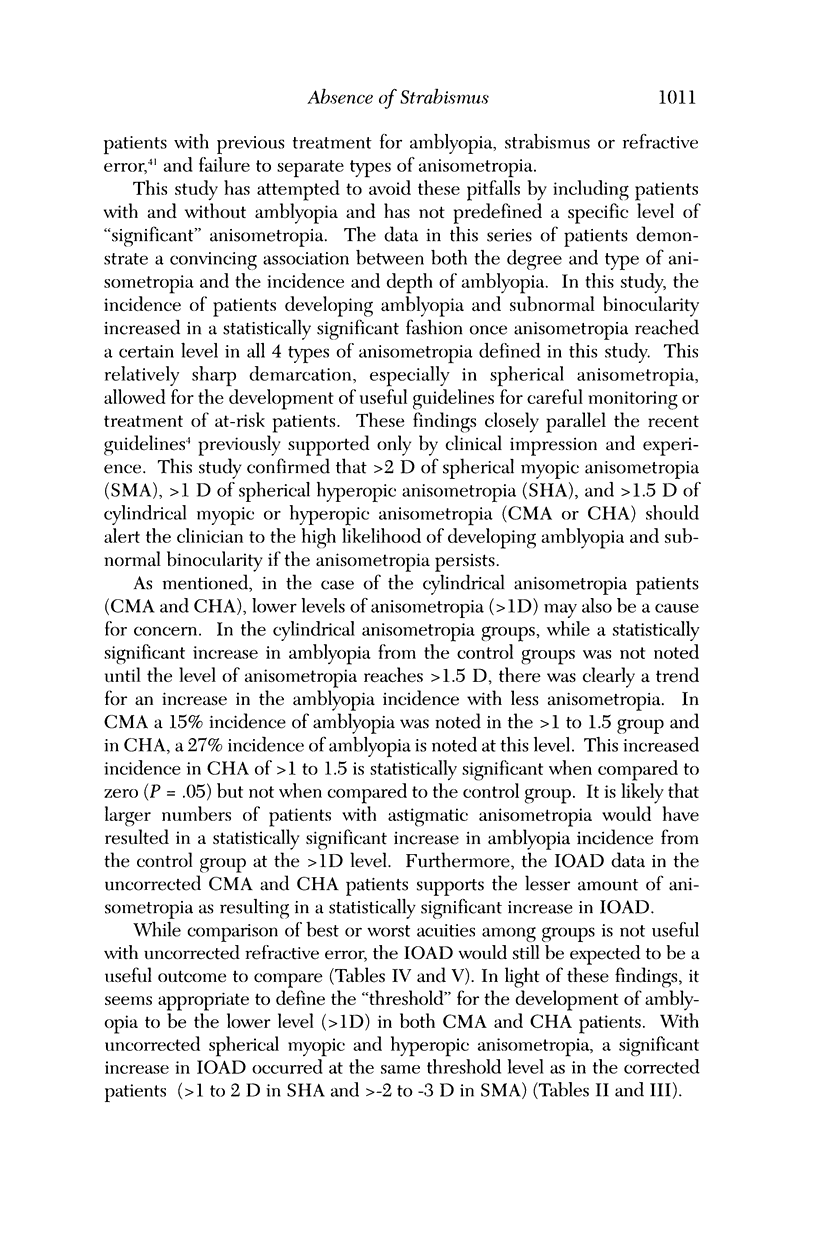
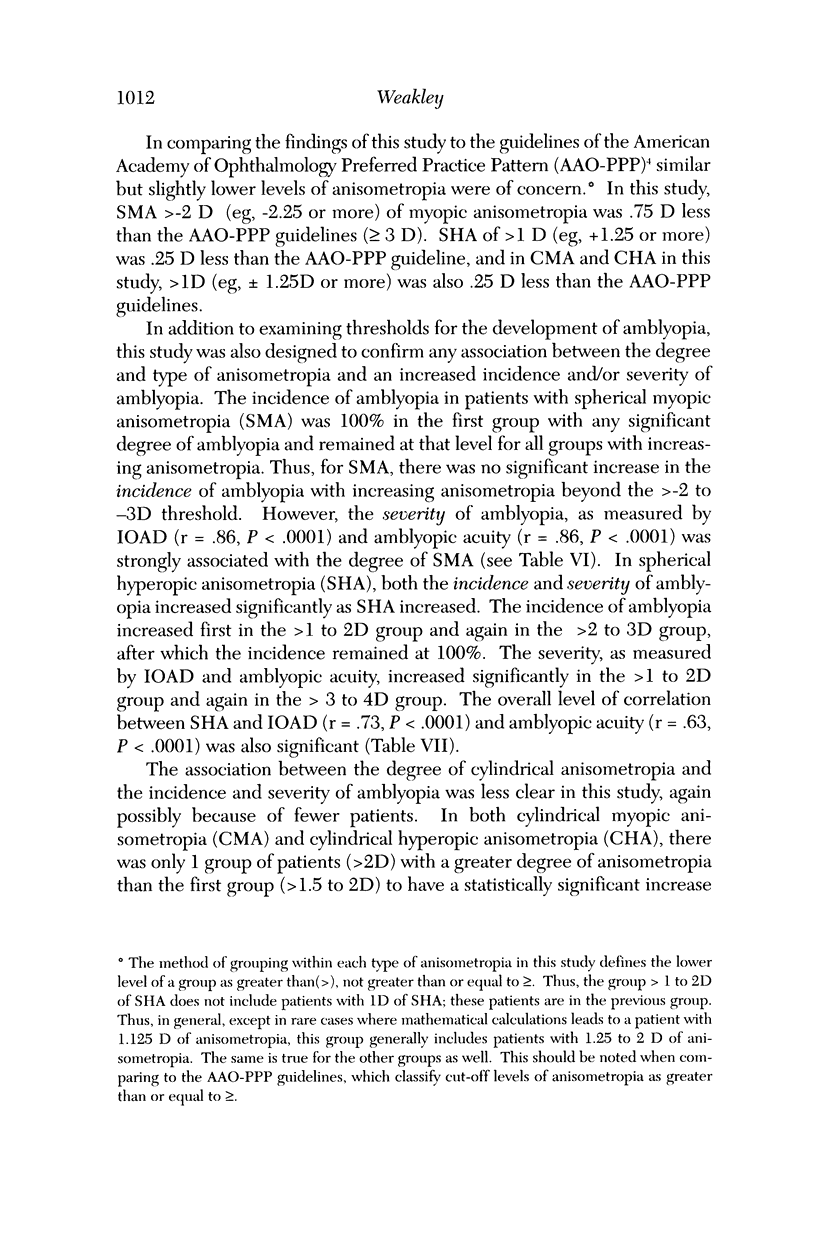

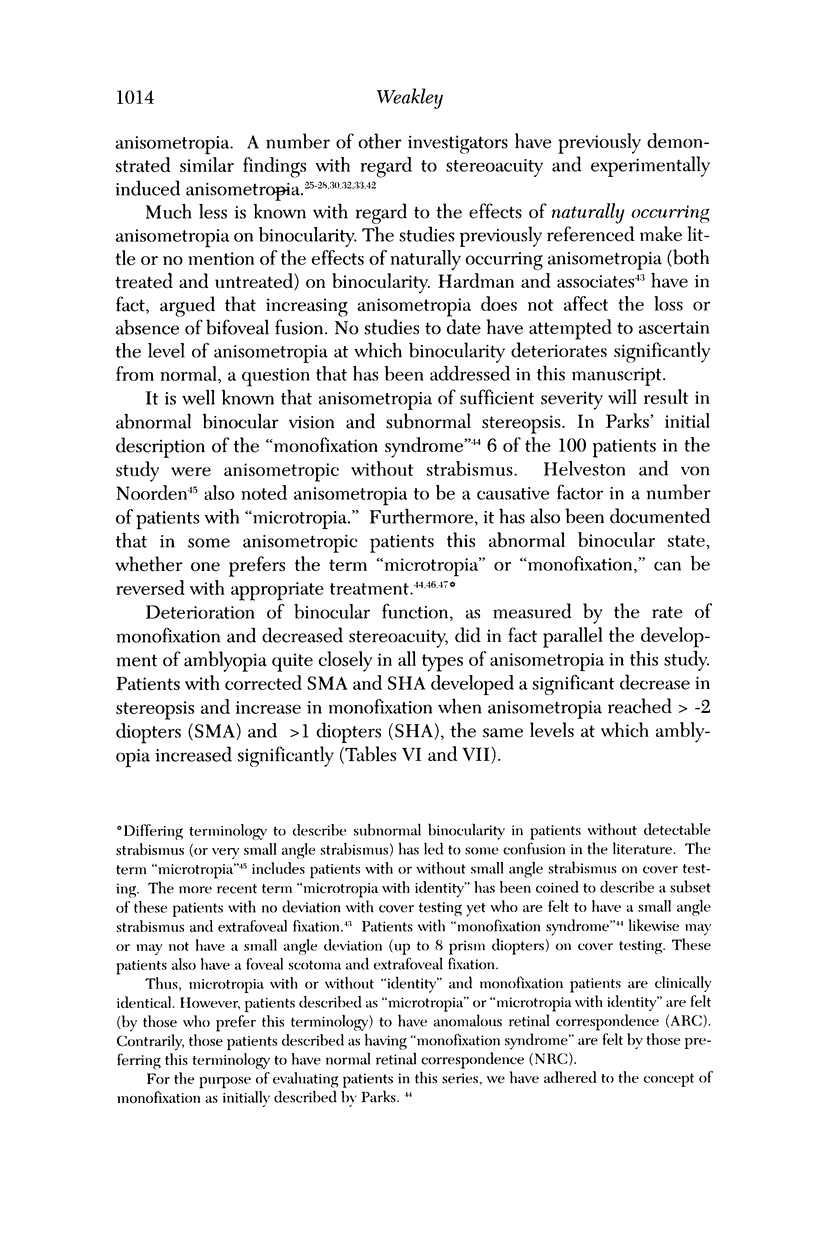
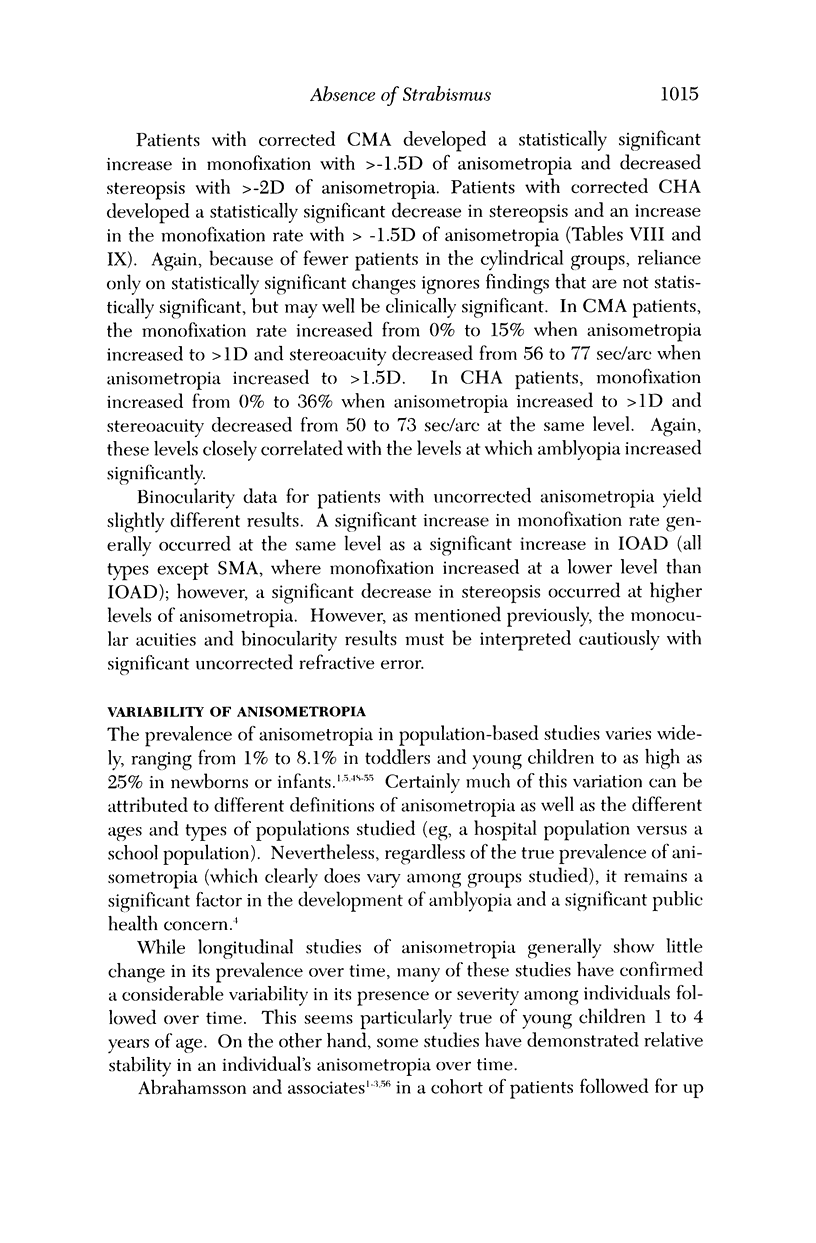
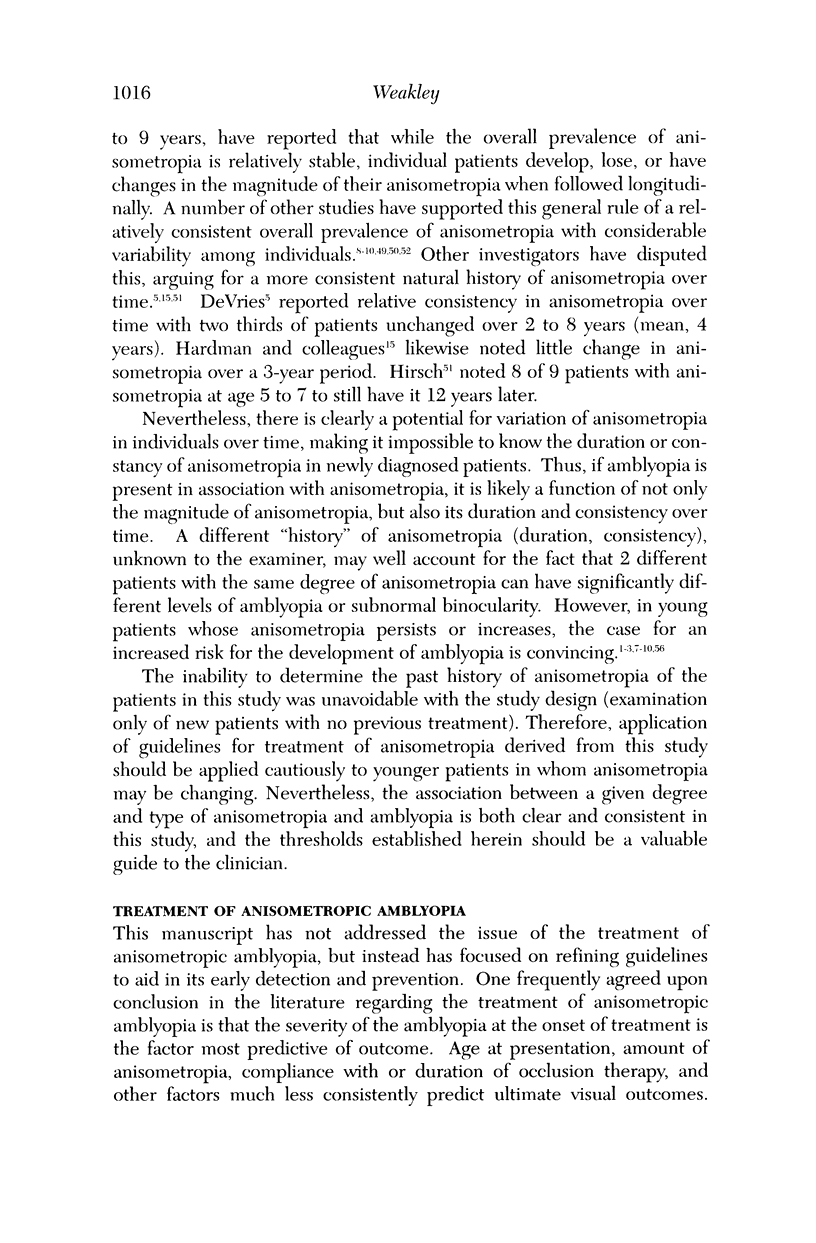
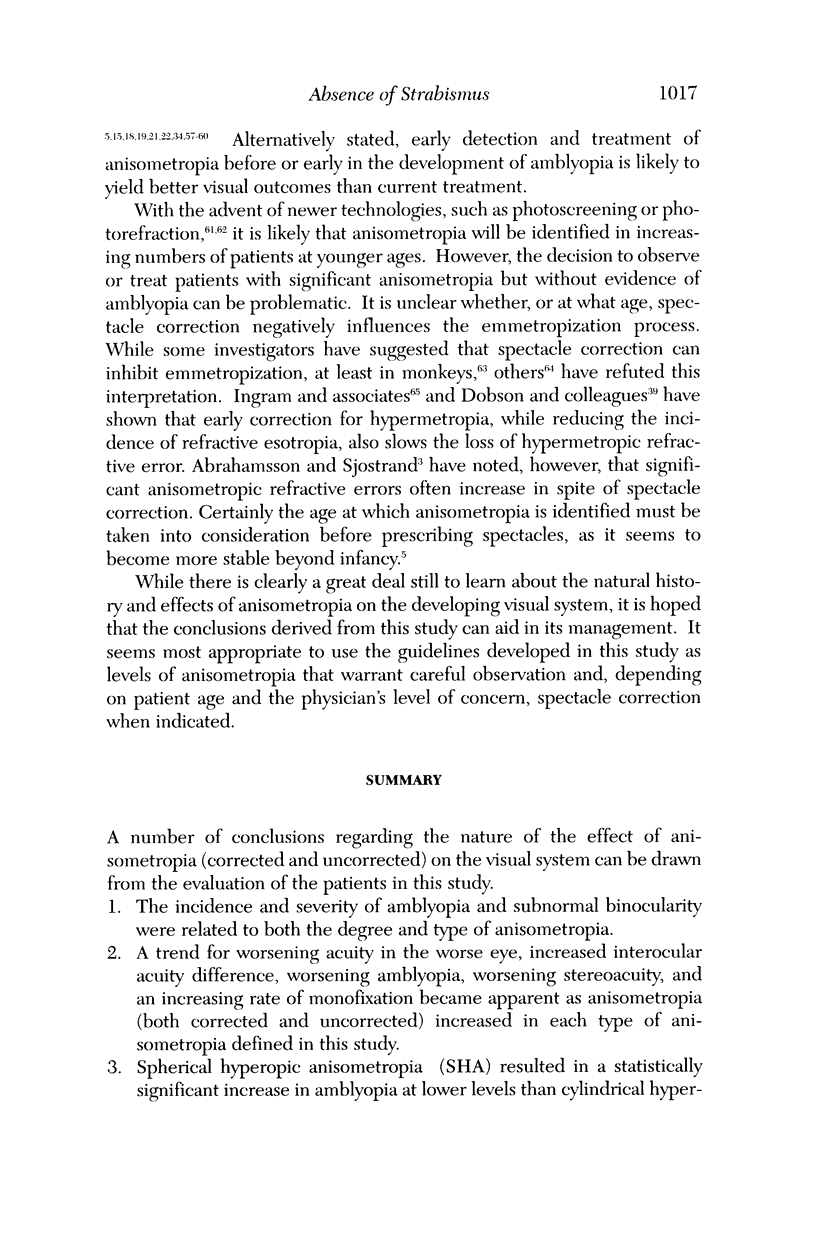
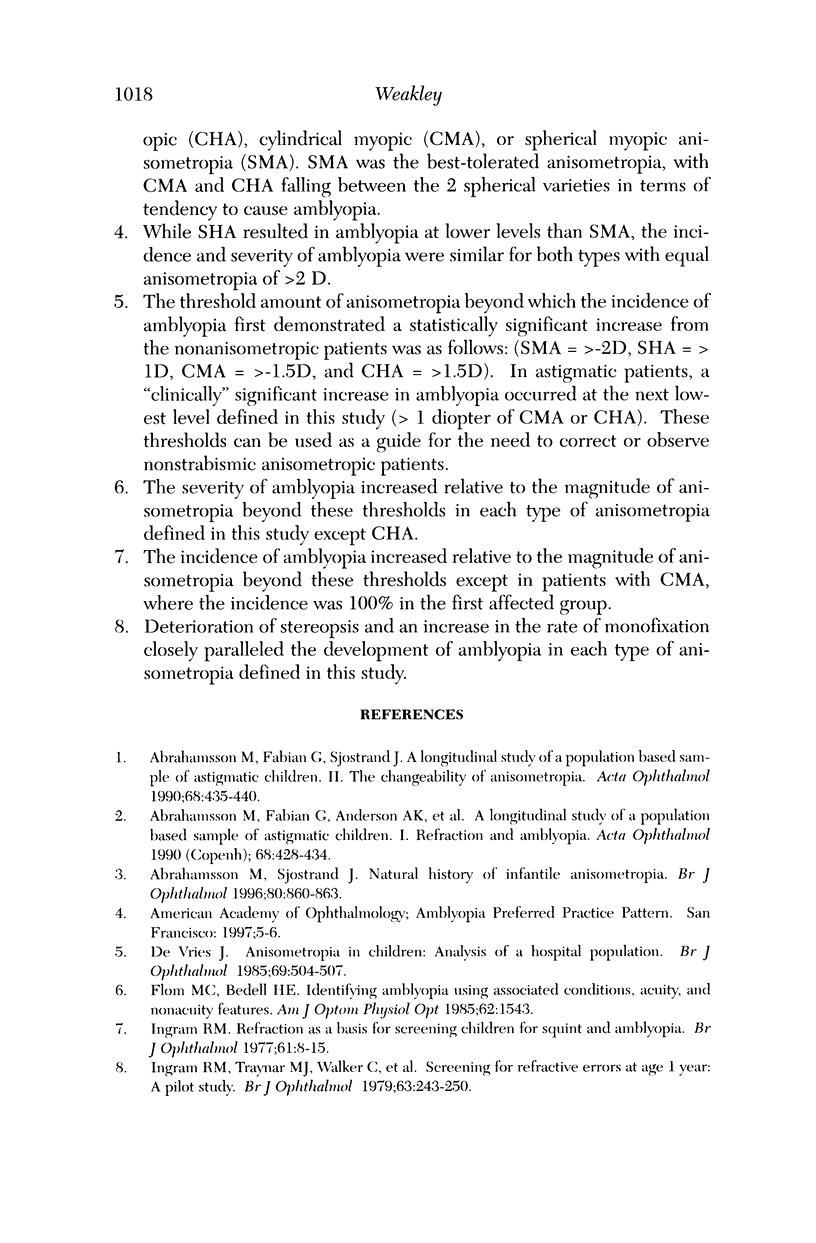
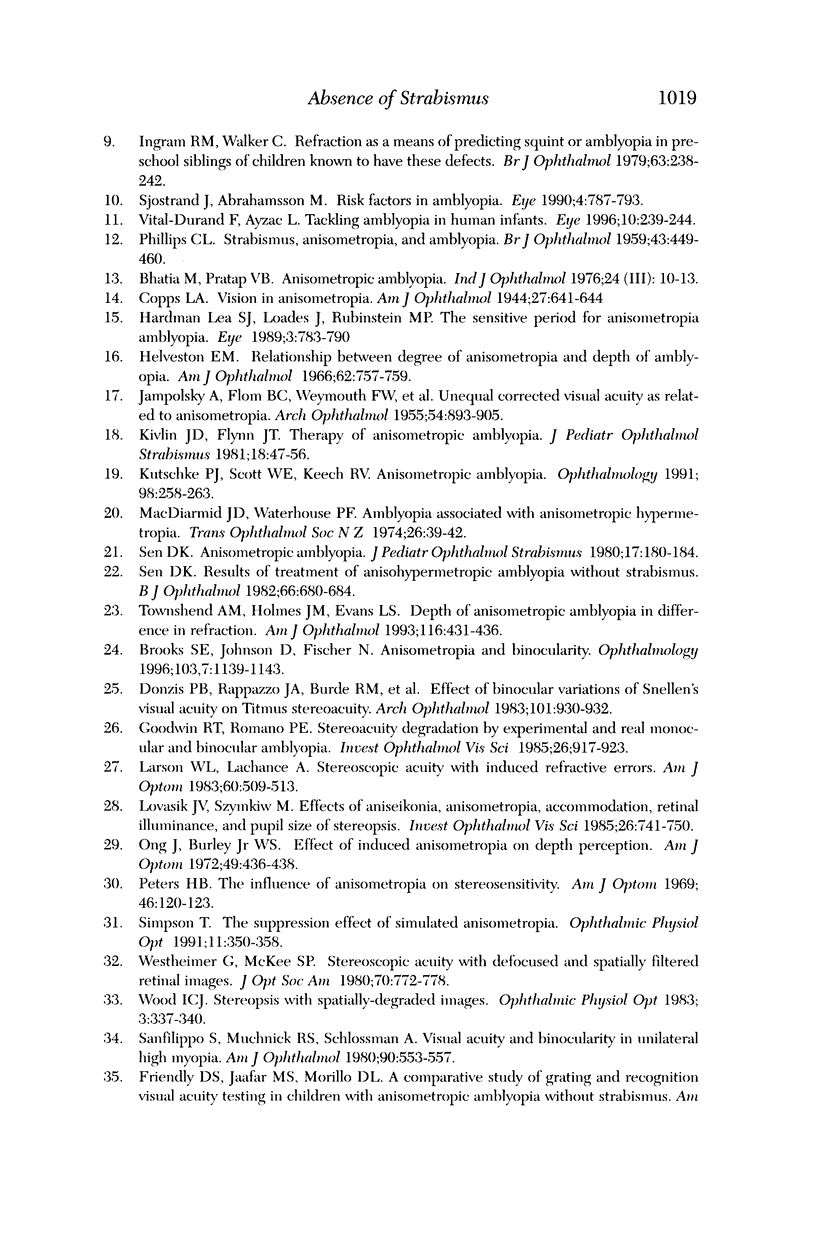
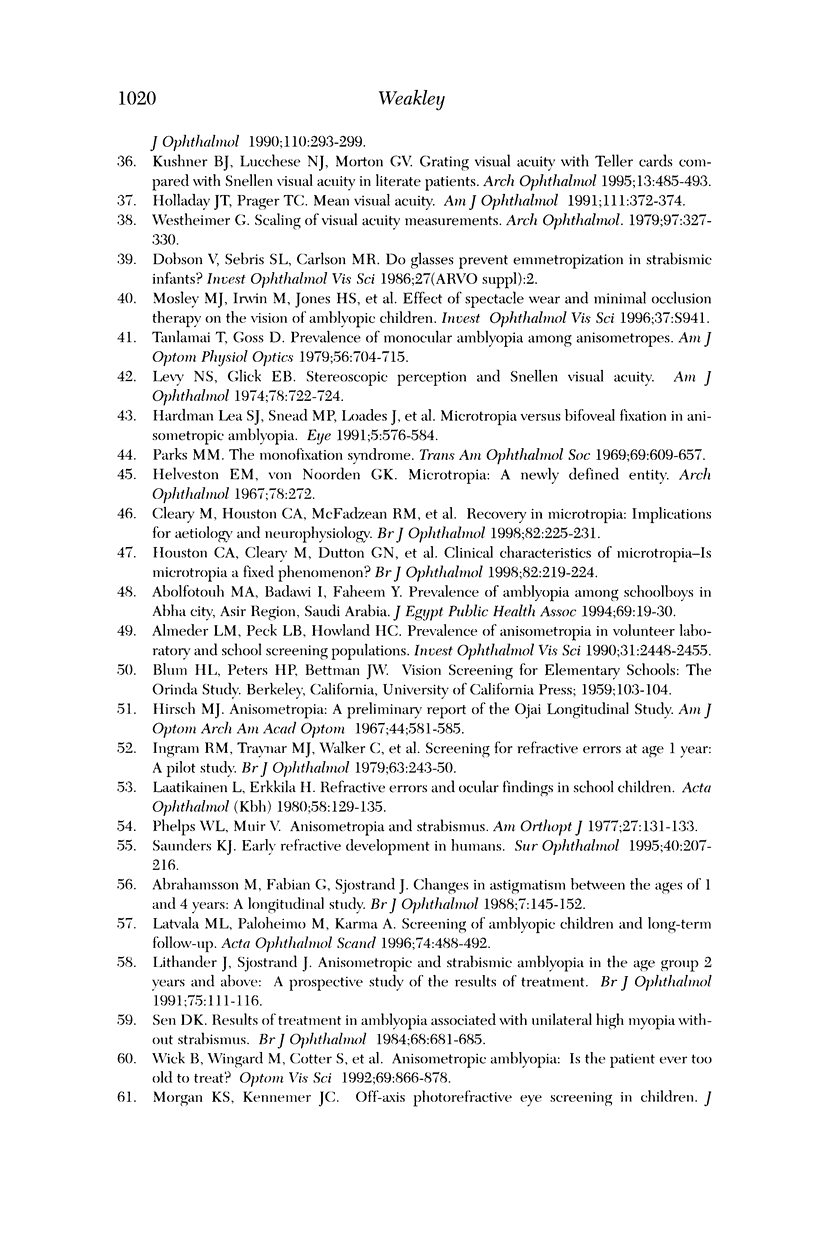
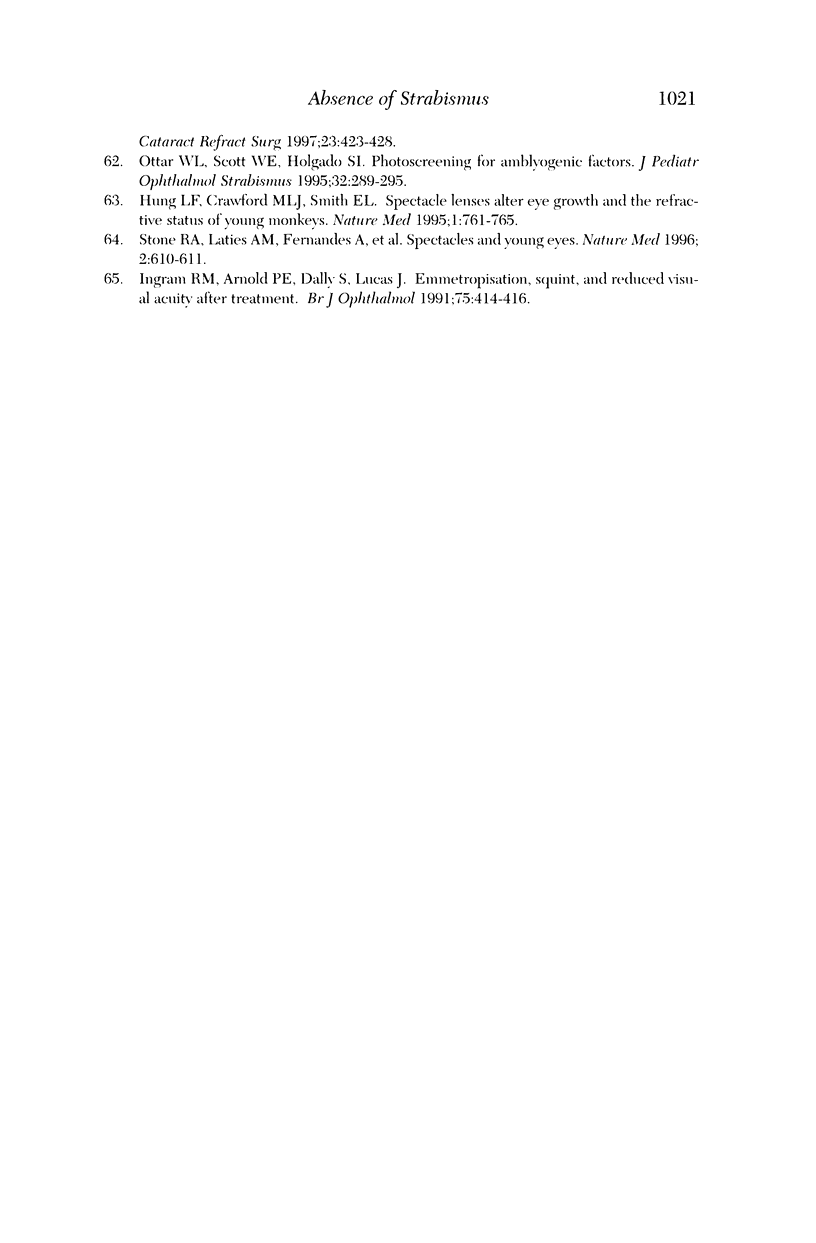
Images in this article
Selected References
These references are in PubMed. This may not be the complete list of references from this article.
- Abolfotouh M. A., Badawi I., Faheem Y. Prevalence of amblyopia among schoolboys in Abha city, Asir Region, Saudi Arabia. J Egypt Public Health Assoc. 1994;69(1-2):19–30. [PubMed] [Google Scholar]
- Abrahamsson M., Fabian G., Andersson A. K., Sjöstrand J. A longitudinal study of a population based sample of astigmatic children. I. Refraction and amblyopia. Acta Ophthalmol (Copenh) 1990 Aug;68(4):428–434. doi: 10.1111/j.1755-3768.1990.tb01671.x. [DOI] [PubMed] [Google Scholar]
- Abrahamsson M., Fabian G., Sjöstrand J. A longitudinal study of a population based sample of astigmatic children. II. The changeability of anisometropia. Acta Ophthalmol (Copenh) 1990 Aug;68(4):435–440. doi: 10.1111/j.1755-3768.1990.tb01672.x. [DOI] [PubMed] [Google Scholar]
- Almeder L. M., Peck L. B., Howland H. C. Prevalence of anisometropia in volunteer laboratory and school screening populations. Invest Ophthalmol Vis Sci. 1990 Nov;31(11):2448–2455. [PubMed] [Google Scholar]
- Bhatia M., Pratap V. B. Anisometropic amblyopia. Indian J Ophthalmol. 1976 Oct;24(3):10–13. [PubMed] [Google Scholar]
- Brooks S. E., Johnson D., Fischer N. Anisometropia and binocularity. Ophthalmology. 1996 Jul;103(7):1139–1143. doi: 10.1016/s0161-6420(96)30555-1. [DOI] [PubMed] [Google Scholar]
- Cleary M., Houston C. A., McFadzean R. M., Dutton G. N. Recovery in microtropia: implications for aetiology and neurophysiology. Br J Ophthalmol. 1998 Mar;82(3):225–231. doi: 10.1136/bjo.82.3.225. [DOI] [PMC free article] [PubMed] [Google Scholar]
- Donzis P. B., Rappazzo J. A., Burde R. M., Gordon M. Effect of binocular variations of Snellen's visual acuity on Titmus stereoacuity. Arch Ophthalmol. 1983 Jun;101(6):930–932. doi: 10.1001/archopht.1983.01040010930016. [DOI] [PubMed] [Google Scholar]
- Goodwin R. T., Romano P. E. Stereoacuity degradation by experimental and real monocular and binocular amblyopia. Invest Ophthalmol Vis Sci. 1985 Jul;26(7):917–923. [PubMed] [Google Scholar]
- Hardman Lea S. J., Loades J., Rubinstein M. P. The sensitive period for anisometropic amblyopia. Eye (Lond) 1989;3(Pt 6):783–790. doi: 10.1038/eye.1989.122. [DOI] [PubMed] [Google Scholar]
- Hardman Lea S. J., Snead M. P., Loades J., Rubinstein M. P. Microtropia versus bifoveal fixation in anisometropic amblyopia. Eye (Lond) 1991;5(Pt 5):576–584. doi: 10.1038/eye.1991.100. [DOI] [PubMed] [Google Scholar]
- Helveston E. M. Relationship between degree of anisometropia and depth of amblyopia. Am J Ophthalmol. 1966 Oct;62(4):757–759. doi: 10.1016/0002-9394(66)92207-0. [DOI] [PubMed] [Google Scholar]
- Helveston E. M., Von Noorden G. K. Microtropia. A newly defined entity. Arch Ophthalmol. 1967 Sep;78(3):272–281. doi: 10.1001/archopht.1967.00980030274003. [DOI] [PubMed] [Google Scholar]
- Hirsch M. J. Anisometropia: a preliminary report of the Ojai Longitudinal Study. Am J Optom Arch Am Acad Optom. 1967 Sep;44(9):581–585. [PubMed] [Google Scholar]
- Holladay J. T., Prager T. C. Mean visual acuity. Am J Ophthalmol. 1991 Mar 15;111(3):372–374. doi: 10.1016/s0002-9394(14)72328-1. [DOI] [PubMed] [Google Scholar]
- Houston C. A., Cleary M., Dutton G. N., McFadzean R. M. Clinical characteristics of microtropia--is microtropia a fixed phenomenon? Br J Ophthalmol. 1998 Mar;82(3):219–224. doi: 10.1136/bjo.82.3.219. [DOI] [PMC free article] [PubMed] [Google Scholar]
- Hung L. F., Crawford M. L., Smith E. L. Spectacle lenses alter eye growth and the refractive status of young monkeys. Nat Med. 1995 Aug;1(8):761–765. doi: 10.1038/nm0895-761. [DOI] [PubMed] [Google Scholar]
- Ingram R. M., Arnold P. E., Dally S., Lucas J. Emmetropisation, squint, and reduced visual acuity after treatment. Br J Ophthalmol. 1991 Jul;75(7):414–416. doi: 10.1136/bjo.75.7.414. [DOI] [PMC free article] [PubMed] [Google Scholar]
- Ingram R. M. Refraction as a basis for screening children for squint and amblyopia. Br J Ophthalmol. 1977 Jan;61(1):8–15. doi: 10.1136/bjo.61.1.8. [DOI] [PMC free article] [PubMed] [Google Scholar]
- Ingram R. M., Traynar M. J., Walker C., Wilson J. M. Screening for refractive errors at age 1 year: a pilot study. Br J Ophthalmol. 1979 Apr;63(4):243–250. doi: 10.1136/bjo.63.4.243. [DOI] [PMC free article] [PubMed] [Google Scholar]
- Ingram R. M., Traynar M. J., Walker C., Wilson J. M. Screening for refractive errors at age 1 year: a pilot study. Br J Ophthalmol. 1979 Apr;63(4):243–250. doi: 10.1136/bjo.63.4.243. [DOI] [PMC free article] [PubMed] [Google Scholar]
- Ingram R. M., Walker C. Refraction as a means of predicting squint or amblyopia in preschool siblings of children known to have these defects. Br J Ophthalmol. 1979 Apr;63(4):238–242. doi: 10.1136/bjo.63.4.238. [DOI] [PMC free article] [PubMed] [Google Scholar]
- JAMPOLSKY A., FLOM B. C., WEYMOUTH F. W., MOSES L. E. Unequal corrected visual acuity as related to anisometropia. AMA Arch Ophthalmol. 1955 Dec;54(6):893–905. doi: 10.1001/archopht.1955.00930020899013. [DOI] [PubMed] [Google Scholar]
- Kivlin J. D., Flynn J. T. Therapy of anisometropic amblyopia. J Pediatr Ophthalmol Strabismus. 1981 Sep-Oct;18(5):47–56. doi: 10.3928/0191-3913-19810901-12. [DOI] [PubMed] [Google Scholar]
- Kushner B. J., Lucchese N. J., Morton G. V. Grating visual acuity with Teller cards compared with Snellen visual acuity in literate patients. Arch Ophthalmol. 1995 Apr;113(4):485–493. doi: 10.1001/archopht.1995.01100040107035. [DOI] [PubMed] [Google Scholar]
- Kutschke P. J., Scott W. E., Keech R. V. Anisometropic amblyopia. Ophthalmology. 1991 Feb;98(2):258–263. doi: 10.1016/s0161-6420(91)32307-8. [DOI] [PubMed] [Google Scholar]
- Laatikainen L., Erkkilä H. Refractive errors and other ocular findings in school children. Acta Ophthalmol (Copenh) 1980;58(1):129–136. doi: 10.1111/j.1755-3768.1980.tb04576.x. [DOI] [PubMed] [Google Scholar]
- Larson W. L., Lachance A. Stereoscopic acuity with induced refractive errors. Am J Optom Physiol Opt. 1983 Jun;60(6):509–513. doi: 10.1097/00006324-198306000-00011. [DOI] [PubMed] [Google Scholar]
- Latvala M. L., Paloheimo M., Karma A. Screening of amblyopic children and long-term follow-up. Acta Ophthalmol Scand. 1996 Oct;74(5):488–492. doi: 10.1111/j.1600-0420.1996.tb00605.x. [DOI] [PubMed] [Google Scholar]
- Levy N. S., Glick E. B. Stereoscopic perception and Snellen visual acuity. Am J Ophthalmol. 1974 Oct;78(4):722–724. doi: 10.1016/s0002-9394(14)76312-3. [DOI] [PubMed] [Google Scholar]
- Lithander J., Sjöstrand J. Anisometropic and strabismic amblyopia in the age group 2 years and above: a prospective study of the results of treatment. Br J Ophthalmol. 1991 Feb;75(2):111–116. doi: 10.1136/bjo.75.2.111. [DOI] [PMC free article] [PubMed] [Google Scholar]
- Lovasik J. V., Szymkiw M. Effects of aniseikonia, anisometropia, accommodation, retinal illuminance, and pupil size on stereopsis. Invest Ophthalmol Vis Sci. 1985 May;26(5):741–750. [PubMed] [Google Scholar]
- MacDiarmid J. D., Waterhouse P. F. Amblyopia associated with anisometropic hypermetropia. Trans Ophthalmol Soc N Z. 1974;26(0):39–42. [PubMed] [Google Scholar]
- Ottar W. L., Scott W. E., Holgado S. I. Photoscreening for amblyogenic factors. J Pediatr Ophthalmol Strabismus. 1995 Sep-Oct;32(5):289–295. doi: 10.3928/0191-3913-19950901-06. [DOI] [PubMed] [Google Scholar]
- PHILLIPS C. I. Strabismus, anisometropia, and amblyopia. Br J Ophthalmol. 1959 Aug;43:449–460. doi: 10.1136/bjo.43.8.449. [DOI] [PMC free article] [PubMed] [Google Scholar]
- Parks M. M. Th monofixation syndrome. Trans Am Ophthalmol Soc. 1969;67:609–657. [PMC free article] [PubMed] [Google Scholar]
- Peters H. B. The influence of anisometropia on stereosensitivity. Am J Optom Arch Am Acad Optom. 1969 Feb;46(2):120–123. doi: 10.1097/00006324-196902000-00009. [DOI] [PubMed] [Google Scholar]
- Phelps W. L., Muir J. Anisometropia and strabismus. Am Orthopt J. 1977;27:131–133. [PubMed] [Google Scholar]
- Sanfilippo S., Muchnick R. S., Schlossman A. Visual acuity and binocularity in unilateral high myopia. Am J Ophthalmol. 1980 Oct;90(4):553–557. doi: 10.1016/s0002-9394(14)75028-7. [DOI] [PubMed] [Google Scholar]
- Saunders K. J. Early refractive development in humans. Surv Ophthalmol. 1995 Nov-Dec;40(3):207–216. doi: 10.1016/s0039-6257(95)80027-1. [DOI] [PubMed] [Google Scholar]
- Sen D. K. Anisometropic amblyopia. J Pediatr Ophthalmol Strabismus. 1980 May-Jun;17(3):180–184. doi: 10.3928/0191-3913-19800501-13. [DOI] [PubMed] [Google Scholar]
- Sen D. K. Results of treatment in amblyopia associated with unilateral high myopia without strabismus. Br J Ophthalmol. 1984 Sep;68(9):681–685. doi: 10.1136/bjo.68.9.681. [DOI] [PMC free article] [PubMed] [Google Scholar]
- Sen D. K. Results of treatment of anisohypermetropic amblyopia without strabismus. Br J Ophthalmol. 1982 Oct;66(10):680–684. doi: 10.1136/bjo.66.10.680. [DOI] [PMC free article] [PubMed] [Google Scholar]
- Sjöstrand J., Abrahamsson M. Risk factors in amblyopia. Eye (Lond) 1990;4(Pt 6):787–793. doi: 10.1038/eye.1990.124. [DOI] [PubMed] [Google Scholar]
- Stone R. A., Laties A. M., Fernandes A., Tigges M. Spectacles and young eyes. Nat Med. 1996 Jun;2(6):610–612. doi: 10.1038/nm0696-610b. [DOI] [PubMed] [Google Scholar]
- Tanlamai T., Goss D. A. Prevalence of monocular amblyopia among anisometropes. Am J Optom Physiol Opt. 1979 Nov;56(11):704–715. doi: 10.1097/00006324-197911000-00006. [DOI] [PubMed] [Google Scholar]
- Townshend A. M., Holmes J. M., Evans L. S. Depth of anisometropic amblyopia and difference in refraction. Am J Ophthalmol. 1993 Oct 15;116(4):431–436. doi: 10.1016/s0002-9394(14)71400-x. [DOI] [PubMed] [Google Scholar]
- Vital-Durand F., Ayzac L. Tackling amblyopia in human infants. Eye (Lond) 1996;10(Pt 2):239–244. doi: 10.1038/eye.1996.52. [DOI] [PubMed] [Google Scholar]
- Wick B., Wingard M., Cotter S., Scheiman M. Anisometropic amblyopia: is the patient ever too old to treat? Optom Vis Sci. 1992 Nov;69(11):866–878. doi: 10.1097/00006324-199211000-00006. [DOI] [PubMed] [Google Scholar]






